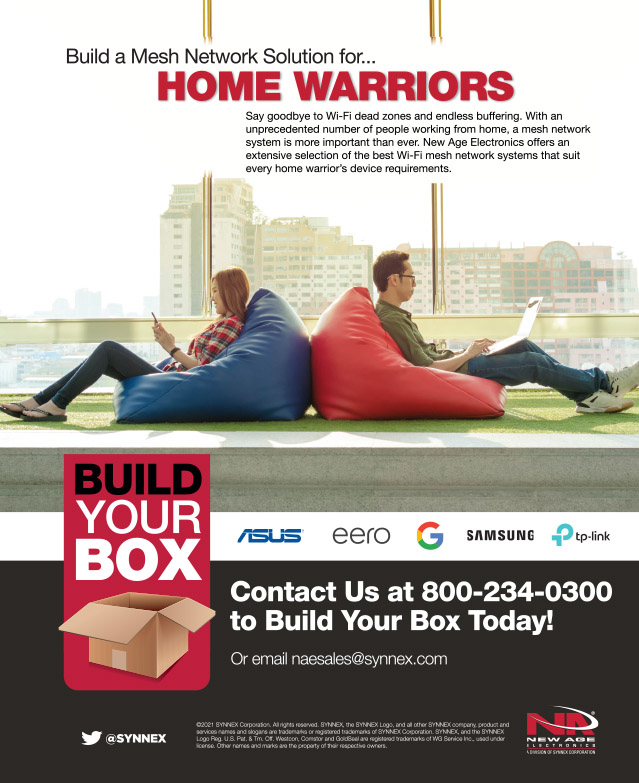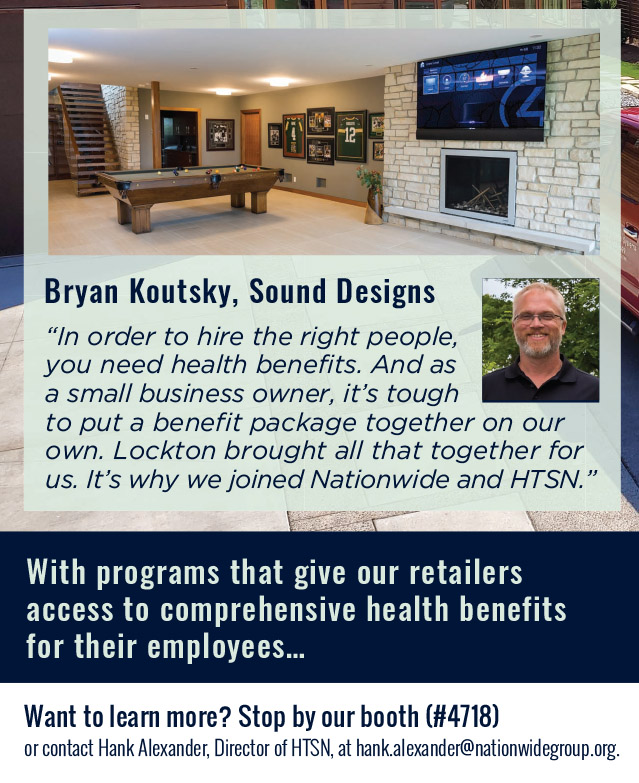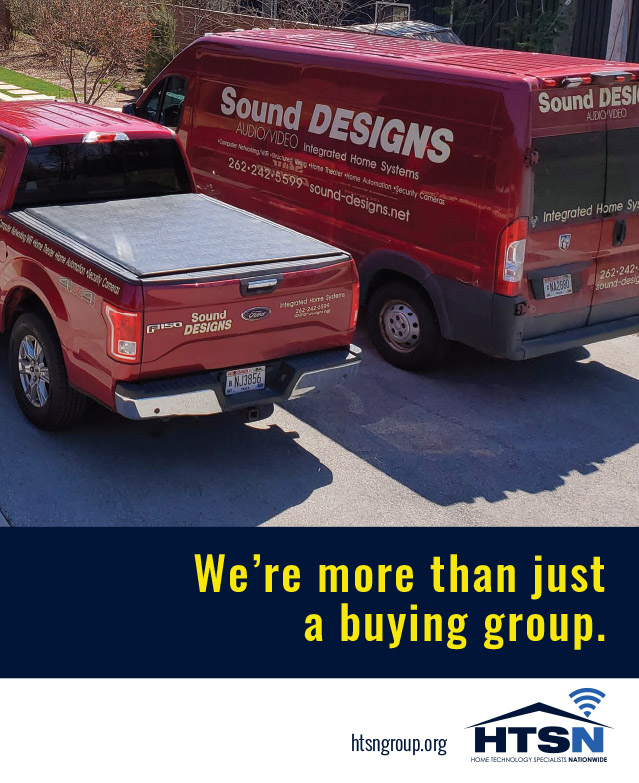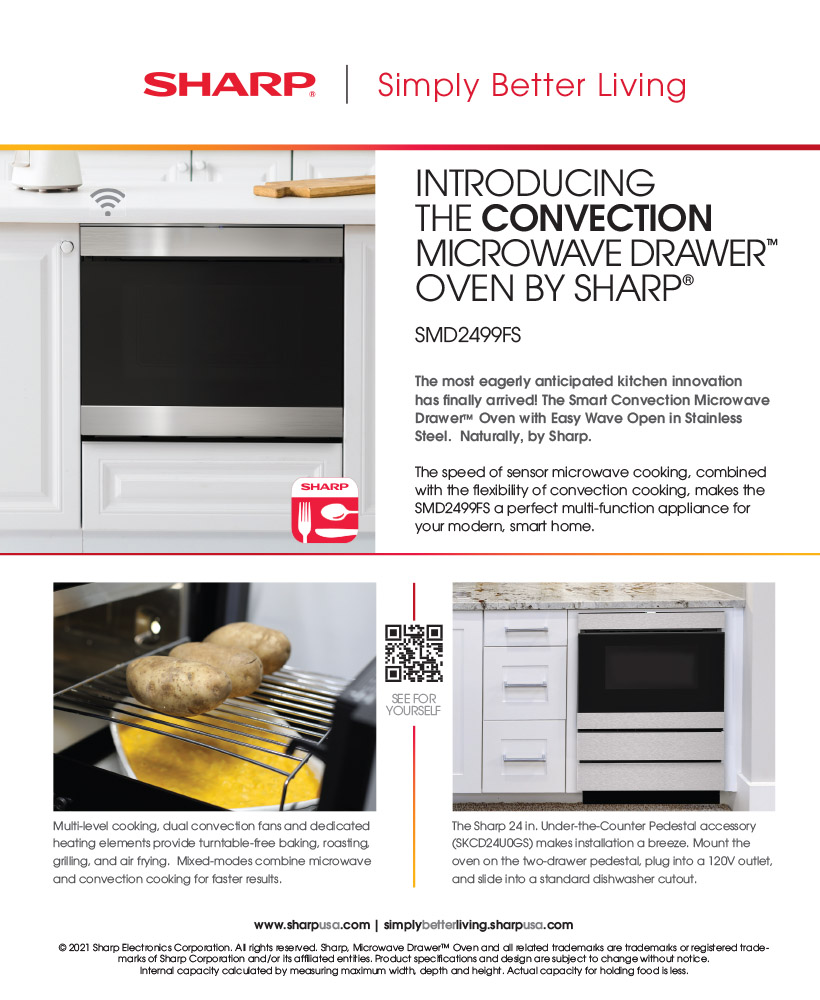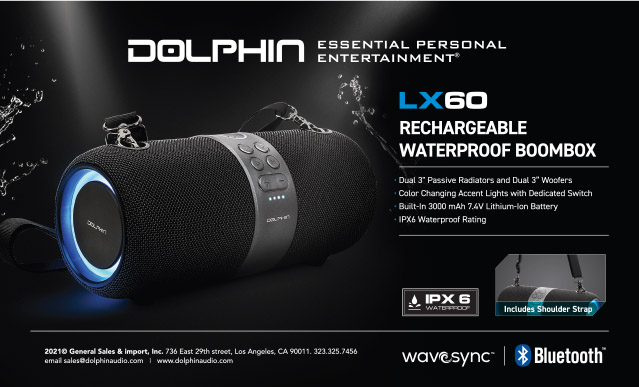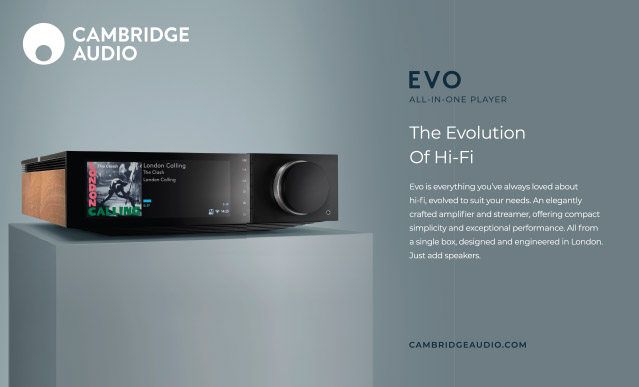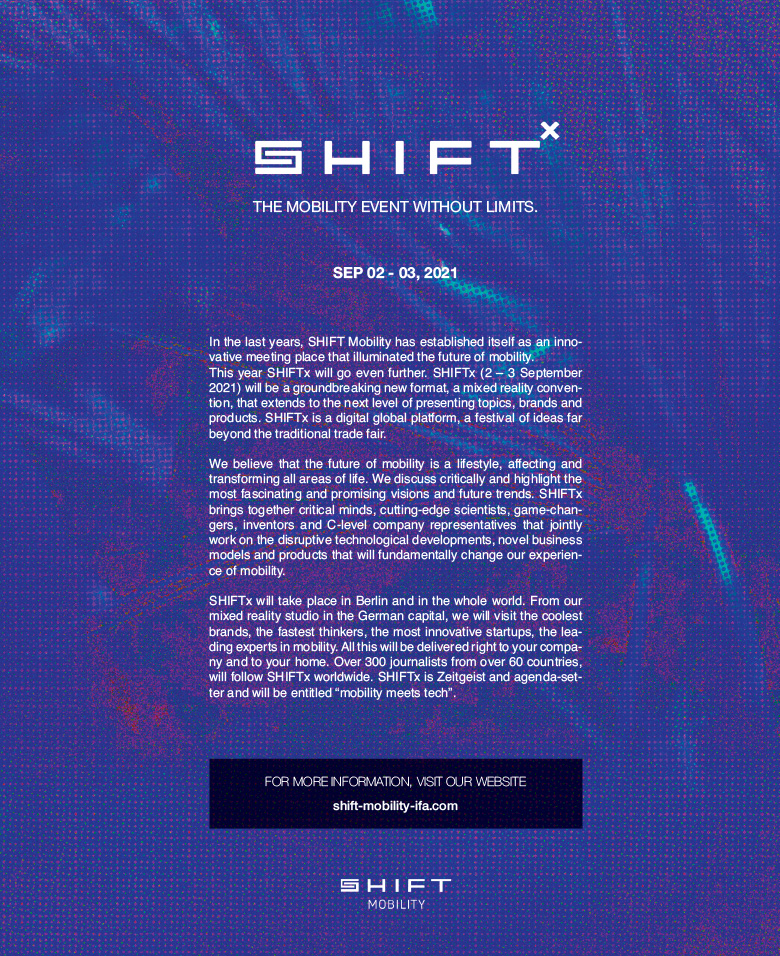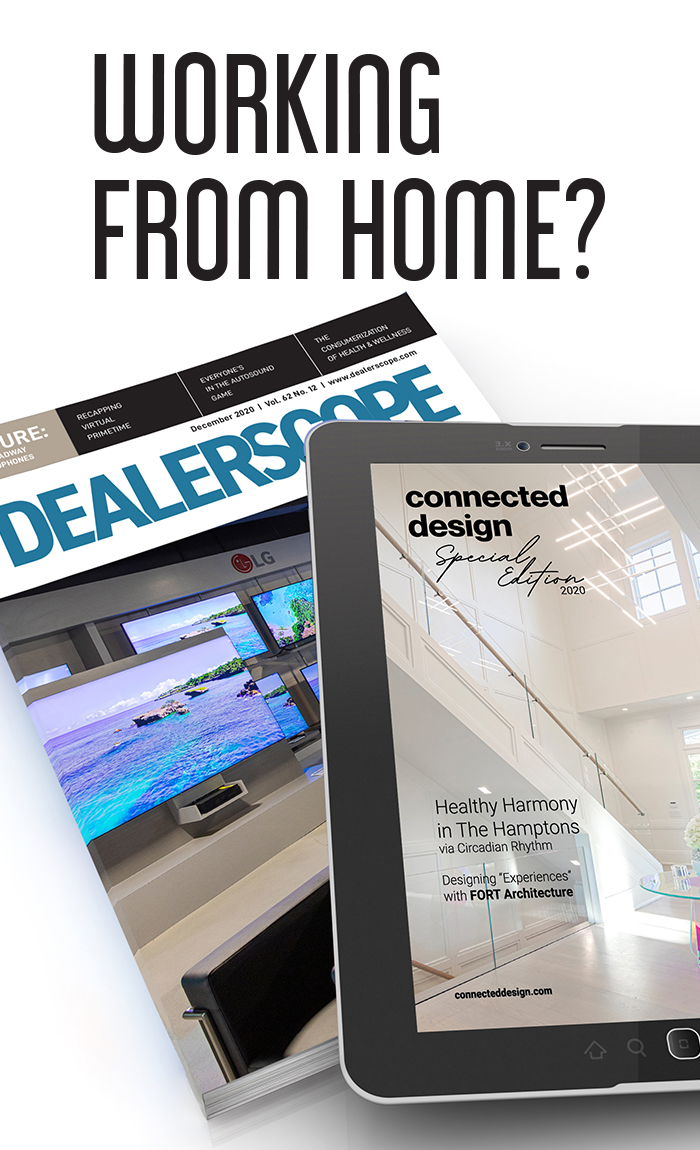Inside the Dealerscope September 2021 DigiMag: Discover how our 2021 Retail Excellence Award winners pivoted and persisted through the pandemic year and came out on top. Plus, the benefits of "3D Commerce," the coolest new refrigerator technologies, and a guide to the latest e-bikes, a hot and growing category that every smart CE retailers must consider. And lastly, watch 'Dealerscope Insider Look,' a new series in which we interview the experts and leaders in the consumer electronics and appliance sectors, shot at Nationwide PrimeTime in Nashville.
A September to Remember

Hard to believe we are in the last four months of the year, already — and gearing up to have “in-person” events such CEDIA Expo in Indianapolis, and several buying group shows such as Nationwide Primetime and BrandSource, in Nashville, etc. I am excited to start seeing each of you at these events. It will be a refreshing way to do business again.
As we enter this stretch of time, Dealerscope is honored to partner with Value Electronics to host their TV Shootout in NYC on September 12. We look forward in anticipation to learn who will be crowned “King of TV’s” for 2021. In addition, for the first time ever, on September 13, we will produce our Projector Shootout, where companies will go head-to-head to see who is the best in short-throw projectors. This will be something not to miss.
Covering the world of TVs, Vanessa Zitzmann contributes to this issue with an article on “Five Things to Know About 8K.” I can’t wait to read this piece. We will also look at why, worldwide, video game hardware sales are doing so well during the pandemic.
Our annual Dealerscope Retail Excellence Awards are also in our September issue. I congratulate our honorees: InMotion, Audio46, and Orsini’s. These retailers are all doing great things in their brick-and-mortar stores and through their e-commerce presence. Make sure to check out their profiles.
We also present our Fall Warranty Roundup — an overview of the new solutions these companies are offering to support the Consumer Electronics and Appliance categories.
Our editorial team is doing an E-bike roundup in our “Unboxed” column, and “Health & Wellness” explores how workouts have become the killer app for VR. We also take a closer look at how to address inventory in a non-traditional way, in “3D Commerce: The Building Blocks of Virtual Inventory.”
And speaking of retail, we interview Eden Goldberg, VP, Marketing & Business Development at InMotion, and Pete Newbould, Managing Director & SVP InMotion Stores, Marshall Retail Group, WHSmith PLC, on travel tech and how this category is taking off.
Of course, month after month, we will offer other articles to help you conduct your day-to-day business more effectively. We always strive to keep Dealerscope important to you, and want to keep earning your support of our brand and content. Please know that you are appreciated.
As always, please feel free to get in touch with me at tmonteleone@ctlab.media.
Tony Monteleone,
Group Publisher of CT Lab Global Media
A WORD FROM OUR EDITOR IN CHIEF
Top trends in e-commerce right now

Now more than ever, e-commerce is a channel that no retailer can ignore. That’s why, for those who are already knee-deep in e-commerce, this month’s issue features two stories that outline some ways to supercharge online sales initiatives with compelling content on product pages. But product content aside, what are some of the biggest trends in e-commerce right now? For that, I turned to GGV Capital Managing Partner Hans Tung, whose early-stage investment portfolio includes consumer financing company Affirm, home fitness electronics brand Peloton, shopping app Wish, and e-commerce startup Poshmark. Here are three of Tung’s top e-commerce trends right now.
Amazon continues its skyrocketing growth, but so does Shopify
“Five or ten years ago, the debate was Amazon versus Walmart or Amazon versus eBay, but you don’t see that anymore,” says Tung. Instead, it’s Amazon versus Shopify. “Amazon is this 800-pound gorilla that is starting to do its own private-label versions of products that are selling well on Amazon. So now, all of the brands are starting to worry that putting all of their eggs in one basket is running the risk of helping Amazon get more data to come up with private-label versions of their products.” As such, brands and retailers are increasingly going to Shopify to kickstart their e-commerce initiatives in ways that won’t necessarily spawn greater competition from Amazon or even Facebook.
Buy-now-pay-later financing is replacing credit card transactions
As e-commerce grows, so do latter-day layaway plan financing services such as Affirm, Afterpay, and Klarna, which doubled in users in just one year. One of the reasons for this growth is that, unlike with credit cards, shoppers don’t have to pay any additional interest when using buy-now-pay-later services. “Instead of spending money on marketing,” Tung says, “these services pay the interest for you.” Interestingly, this financing trend started in Brazil, which has more buy-now-pay-later transactions than any other country, but Tung sees the use of these payment services growing in the U.S., particularly for big-ticket items such as consumer electronics and appliances. “More people and brands are starting to embrace it,” he says. “Peloton has done well with buy-now-pay-later; it’s one of the fastest-growing parts of Peloton’s business. I can also see it doing well with appliance retail; people would rather pay off big purchases over 24 or 36 months.”
Livestream shopping is huge in China,
but it’s not quite ready for primetime in the U.S .— yet
“Amazon and eBay started in the U.S., but it’s now coming back full circle because more e-commerce and innovation is happening in China,” says Tung. “Livestream shopping in the U.S. is getting a lot of buzz, but in terms of volume it’s still on the small side.” Even though Facebook, YouTube, TikTok, and other live video giants are dipping their toes in the livestream shopping arena, “it’ll take more refinement and iterations to get it right,” says Tung.
There are certainly more gems of e-commerce wisdom such as these from Tung and other experts in the field. We’ll make sure to keep sharing these in the coming weeks and months in the pages of this magazine and online at dealerscope.com.

Tom Samiljan
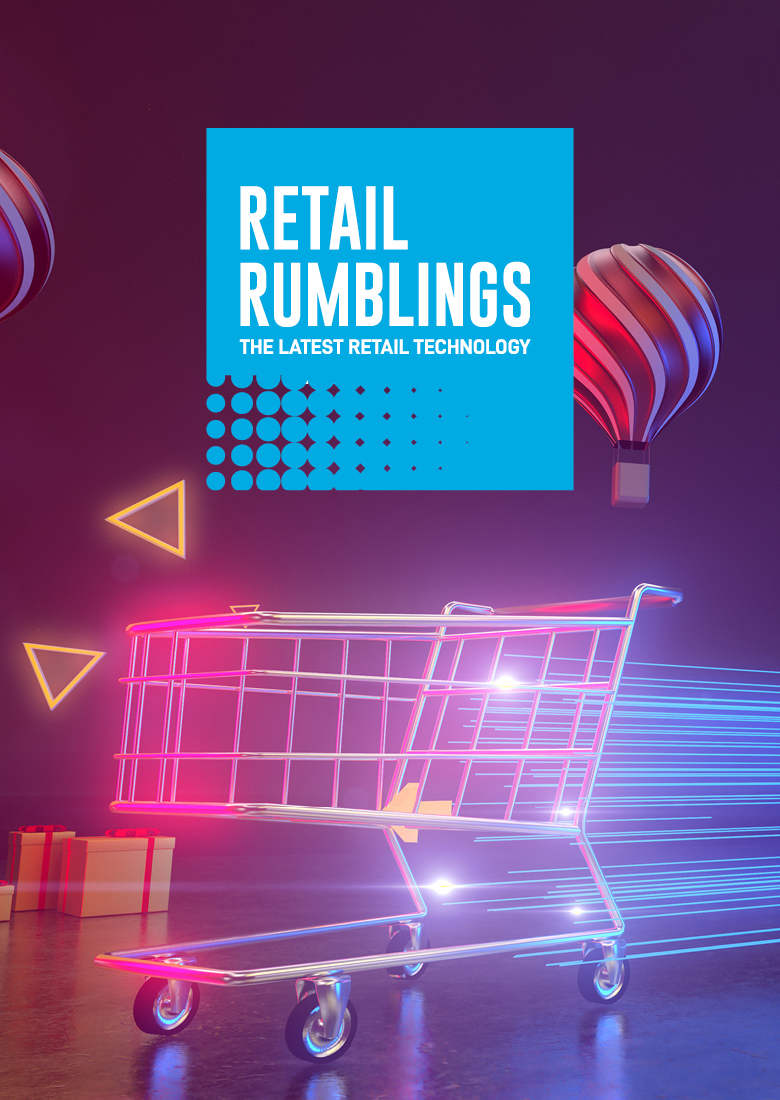
CE RETAIL TECHNOLOGY
September 2021 CE News

Mask Requirements
Return to Large Retailers |
Many large retailers such as Home Depot, Walmart, Target, and Apple are reinstituting mask mandates for employees across the country, beginning in areas that are high risk for COVID-19. The move comes on the heels of the CDC’s announcement recommending that vaccinated members of the populace resume wearing masks, as vaccinated people may be also able to transmit the Delta variant. The mask mandate is a clear sign that the coronavirus pandemic continues to be a challenge to retail businesses.
Foot Traffic Back to Pre-COVID Levels for Some Shopping Centers |
Kimco, owner of more than 400 shopping centers around the country, announced that foot traffic within its shopping centers over the second quarter of 2021 is back to pre-pandemic levels. Last-mile retail has become more valuable to the consumer, as retailers have figured out how to cater to customer needs through in-store and curbside pickup, as well as making returns easier.


Global Floods Also Wreaking Havoc on Toy Supply Chains |
It may be best to get your holiday shopping in early this year as retailers are expecting major shipping shortages to affect product availability into late 2021. Large floods are crippling infrastructure across Western Europe and China’s Henan province, causing major disruptions to global supply chains. Shipping containers are currently in short supply, so much so that toy makers are being charged $20,000 to $25,000 per 40-foot container, which would have previously cost only $3,000 to $4,000 just one year ago.
Retailers Fight Theft by Disabling Stolen Goods Via Bluetooth |
New Bluetooth technology that disables stolen goods once they are removed from a store is being used to fight theft in large retail outlets. Everything from iPhones to Black & Decker drills can be made unusable to disincentivize theft. Organized retail crime is a major issue pressing large retailers across the nation, accounting for $719,000 out of every $1 billion in sales.


R.I.P, Ron Popeil |
Infomercial “as-seen-on-TV” legend and Ronco Founder Ron Popeil passed away on July 28 at the age of 86. An inventor in his own right, Ron took his father’s invention, the Chop-O-Matic, and rebranded it into the slicing-and-dicing machine known as the Veg-O-Matic. Popeil was one of a kind, operating as the quintessential American television pitchman who solved problems Americans didn’t even know they had.
APPLIANCES
Keeping it Cool
The latest refrigerator technologies keep
food organized, fresh, and healthful.
BY ERINN LOUCKS
Manufacturers are taking cold storage to another level by guaranteeing crisper, fresher foods, and smart technology to help manage both the inventory and the appliance. Whatever a client’s priority — long-lasting vegetables, an easier way to grocery shop, or a full household control center — there is a refrigerator to fulfill that need.
Beko U.S. EverFresh+ Technology

Food waste is a global issue — roughly one-third of all global produce is tossed annually — so Beko is taking a stand to put more on plates and less in the trash. By launching its Fresh Produce Promise at the beginning of the summer, Beko is guaranteeing that fruits and vegetables will remain unspoiled for 30 days with Beko’s EverFresh+ technology, or they will refund your refrigerator purchase.
The EverFresh+ crisper uses breathable smart materials — among other technologies — to maximize humidity and minimize moisture loss. Meanwhile, Active Fresh Blue Light technology recreates photosynthesis conditions to preserve vitamin C and fruit and
vegetable taste. The refrigerators also include ProSmart inverter compressors that enable the fridge to be four times quieter and more energy efficient.
Samsung’s Family Hub Smart Fridge
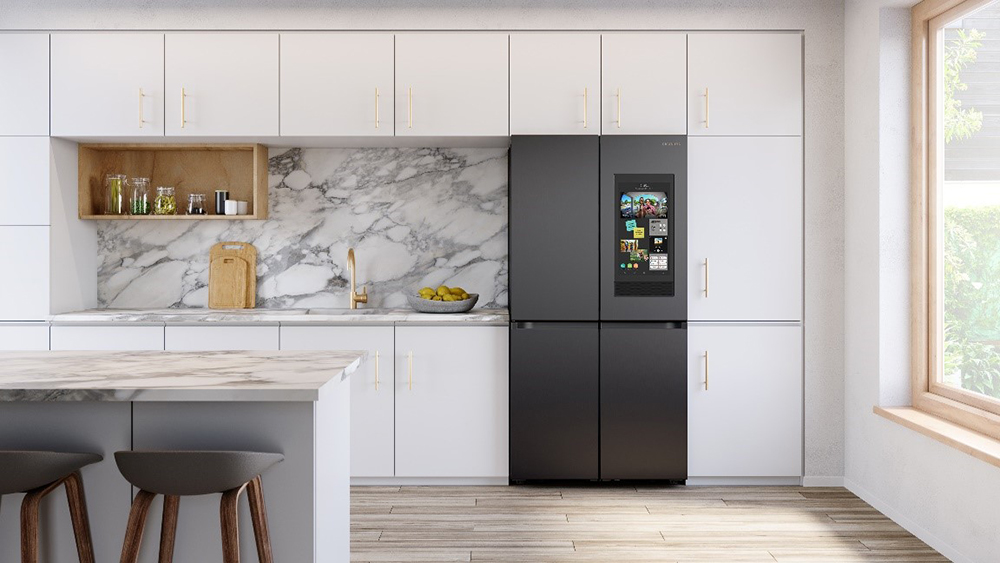
Samsung’s flagship smart refrigerator is much more than efficient cold storage; it’s a control center. This sixth-generation version now works with Amazon’s Alexa voice assistant, although Samsung’s original voice assistant, Bixby, is still available as an option for users. Along with the refrigerator’s original meal-planning features, the Family Hub now has an expanded set of capabilities such as guided cooking and the ability to send instructions to certain synced cooking appliances. All of these features are accessible from the Family Hub screen.
Additional elements characteristic of the smart screen include a shopping list, a meal planner, the ability to tap or swipe to see inside the fridge without opening the door, access to recipes and videos, notes, calendars, whiteboards and memos for family management, and compatibility with several music and entertainment apps. Integration with several leading smart home companies is also possible. Any Samsung Family hub with Generation 2 software or higher can be upgraded to this Generation 6 software.
GE Cafe Refrigerator
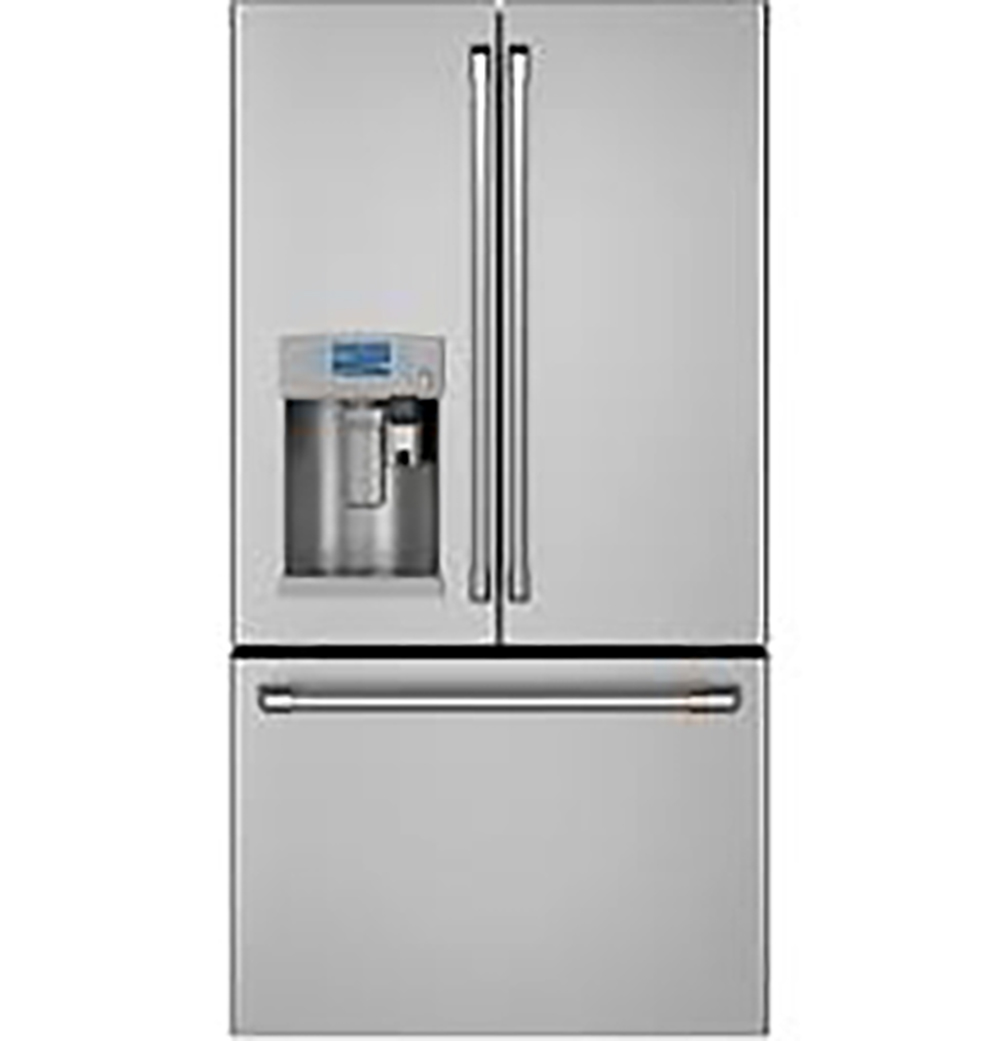

The Cafe Collection by GE focuses on design, including clean lines, a counter-depth and built-in design, and an internal water dispenser, as well as different color and hardware options. A Keurig Coffee Brewing system is also an option for the door. Inside, food is kept fresh with a full-width, electronic temperature-controlled drawer complete with LED lighting. TwinChill evaporators create separate climates in the fresh food and freezer sections.
The refrigerator connects with Alexa, Google Assistant, Sonos, and IFTT. Using the voice assistant, users can schedule their coffee to heat at a certain time, get service notifications, and allow door-open alarms. There is also a hands-free autofill feature that automatically fills any container with filtered water to the desired level.
LG Instaview Door-In-Door Refrigerator


The refrigerator is a big energy user, so keeping the door closed as much as possible saves on money and preserves food for longer. LG makes that possible with its Instaview capabilities, whereby a user needs to only knock on the door twice to see inside. Its Door-in-Door feature allows the user to push a button on the handle of the fridge to open the front panels of the right door; this enables homeowners to grab items out of the in-door shelves without opening the refrigerator fully.
The refrigerator also has connected capabilities with its LGThinQ app, which sends maintenance tips and alerts so that the appliance continues running smoothly. Additional features include a Craft Icemaker, which creates slow-melting, large, round ice for upscale beverages, as well as a Full-Convert Drawer with five different temperature settings.
Bosch 800 Series


At only 21 cubic feet of storage space, this clean and user-friendly design boasts options like a flex bar, and removable shelves and bins to allow for different configurations that suit individual needs. The fridge links with the Home Connect app, which allows the user to monitor and adjust temperatures, change lighting and run diagnostics. The app will also alert the user if a door is left open.
The refrigerator also features the FarmFresh system for preserving food better. The VitaFreshPro technology automatically balances both temperature and humidity levels based on the food setting. Meanwhile, the FreshProtect filter absorbs naturally occurring ethylene to slow the ripening of produce — strawberries, apples, asparagus, and lettuce —- that is sensitive to these gases. Dual compressors and dual evaporators offer efficient cooling and humidity control, while limiting odor transfer between the refrigerator and freezer.
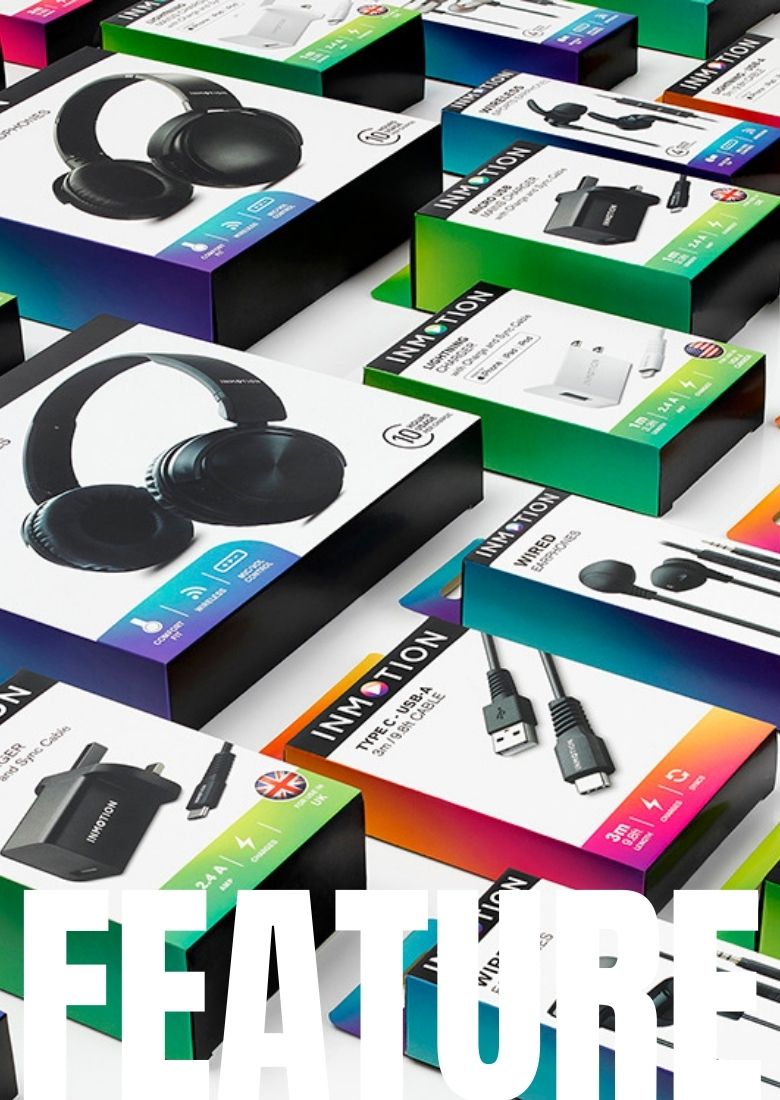

TRAVEL TECH
Taking Off
With people traveling again, airport CE retailer InMotion is moving right along with its expansion.
INTERVIEW BY TOM SAMILJAN
With travel on the rise, airports and hotels are filling up again. This is great news for airport-tech retailer InMotion, which is expanding into hotels, casinos, and airports across the globe. We spoke with Pete Newbould, managing director & SVP of InMotion Stores, and Eden Goldberg, VP of marketing and business development at InMotion Entertainment Group, about the airport retailer’s distinct approach to CE sales, its expansion plans, and how it spent the past year and a half of reduced travel traffic.


How did InMotion get started?
Eden Goldberg: We started in 1997 “rent-tailing” DVDs and DVD players between Seattle and Minneapolis. Our stores carried a small selection of retail products, the top 10 DVDs at the time, and a couple of different models of Panasonic players and headphones. In 2005, we merged with Altitunes, which was the prevalent airport retailer of CDs and DVDs, as well as some portable electronics like the Walkman, DVD players, and headphones. That marriage really made sense from a consumer standpoint and the stores were in complementary markets from the Northwest to the Southeast. So this really helped jumpstart the network of stores. And then, as products started evolving and price points came down, DVD players became less heavy, which helped us migrate more into a retail environment for consumer electronics and entertainment products.
In 2018, we were purchased by WH Smith, which acquired Marshall Retail Group (MRG) around the same time. MRG mostly runs convenience stores and gift shops in resort hotels and casinos. We’re not only providing electronics to existing MRG stores, but we’re also opening up hotel stores under the InMotion brand now. Right now, we have about 120 stores across the globe and are about to add an additional 18 stores at different U.K. airports.


WH Smith has a big brand name — why didn’t it just open stores under its own name?
Pete Newbould: About 15 years ago, WH Smith actually had quite a substantial business in the U.S. in hotels and airports, mostly doing news, gifts, and bookstores, but then we exited in 2003. We never stopped looking at the U.S. as being a very attractive travel market, but one where there are already some very significant players. Looking at the current trends of bids for airport space, we saw that it was going to be tough to do if we didn’t have a kind of a substantial base from which to build. In order to break into it, we realized that we would need to acquire businesses, which is why we acquired InMotion in October of 2018 and then MRG just over a year later. And then COVID hit, so we spent most of 2020 bringing the back end of those businesses together for the sake of efficiency, while ensuring they retained their separate identities.
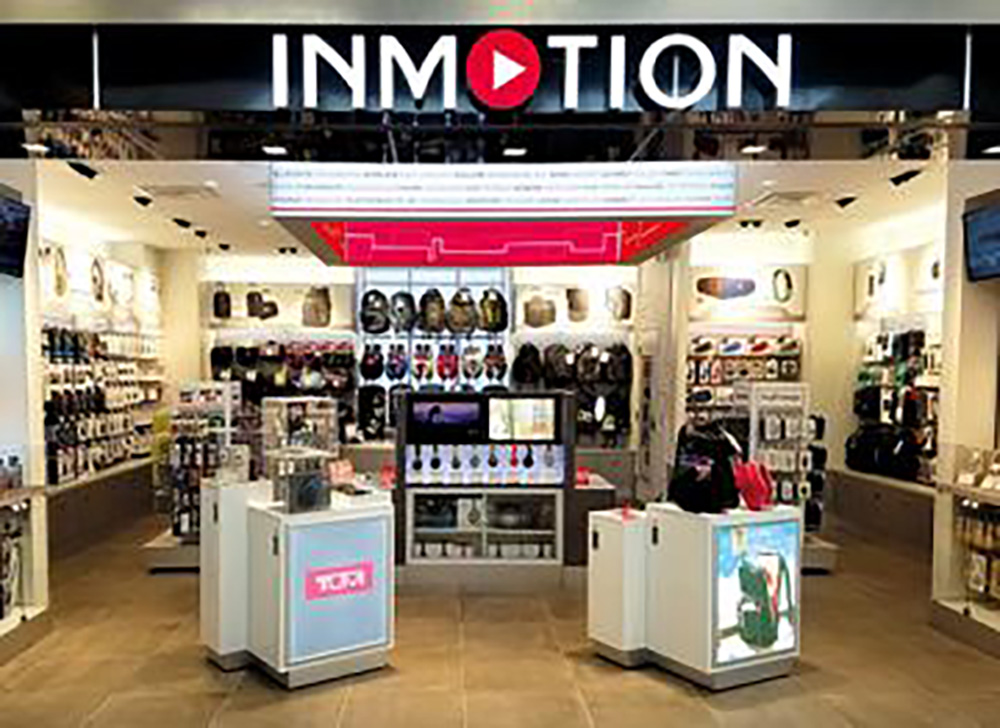

How different is it to operate retail operations
in airports and hotels versus traditional malls?
PN: It’s a very different world from the mall, where you just pay the rent on the space and you more or less have it. Whereas for airports, all space is typically tendered competitively. And in the U.S., it’s done in a particular way that’s different from many other parts of the world. There’s a master concessionaire who sublets space to other retailers. So in bringing InMotion and MRG together, we’re now an effective master concessionaire bidder, whereas WH Smith, by itself, is not. We realized that we needed to be bidding at the level to achieve the level of success we want.
It’s also more difficult, logistically, than running a store in a mall or any kind of traditional big-box store. The customer mode is the most important thing, because their reason for being there is to get on a plane, not to visit shops. On one level, it’s great because we’re presented with customer traffic, and those customers waiting for their flights have time to kill, but we still need to get it across the threshold. And the space also tends to be very small when compared to big-box retailing, so we don’t have a lot of stock space and have to get stock to airside locations. We really have to think about what’s on the customer’s agenda, what products are going to solve their problems and meet their needs, what will inspire them to buy something that they weren’t planning to buy. With big-box retailing, you’re able to present the entire breadth of the category, whereas we really need to narrow down items.
The other challenge is that costs can be very high, since rent is based on a percentage of sales.
And then, in terms of the people we hire, we’re not only looking for exceptional sales people who can empathize with the customer as they’re going through the airport and identify what their needs are, but also people that we can easily get planeside, since it takes time to get them accredited.
What do you do to get customers across that threshold?
EG: People have that mindset of their destination, and not always their journey, so utilizing airport retail as a convenience factor is only part of the formula. We have to find the right solutions that don’t just help a consumer get from A to B, but actually get them to want to use it well beyond their arrival, so that it’s a qualified purchase, a qualified need. Sometimes there’s more of a perceived need — what happens if my phone dies, for example; it’s not quite life or death, but for some of us, it is. How do I make sure that I can still be in touch with my family, friends, and office? How can I make the most out of my trip by capturing the experiences that much more? How do I not only watch and binge my show that I’ve downloaded for my trip, but also use these two wireless earbuds when I work out at the hotel gym, and this charger or Bluetooth adapter? We’re here to provide a full solution and help enable that travel experience.
As you mentioned, once travelers are through security and planeside, they have time to kill — does this mean airport retail has a bright future?
PN: Well, relative to other retail sectors, that could be right, but only if, as Eden just said, we continue to make sure that we’re relevant for the journeys that those passengers are on. We’re very good at turning a need into a want. In other words, if your need is a pair of earbuds to listen to music or watch a movie on your flight, we can facilitate that for you for $20 alright, but it will not be as good of an experience as more premium wireless noise-canceling products that might have a retail price of $200. We’re very good at walking people through the features and benefits of, say, noise-canceling versus non-noise-canceling, and what that’s going to mean for the entertainment experience on their flight. And then we’ll make sure they know that they’ll need a Bluetooth transmitter if they want to watch any movies that are part of the airline’s in-flight entertainment. The success of our business model is the ability to take the need for enough to consumers and turn it into a want that they become so satisfied by.
EG: It’s not just turning the need into the want; it’s also turning that need into a solution and supplementing that with another solution. And making sure that their products can be used in multiple scenarios.
PN: One of the ways we do this is by offering bundles, where for a bit more money, we will add on two products that are relevant to the initial product. So if you’re buying headphones, you might opt for a bundle that also includes a power bank and a Bluetooth transmitter.
What kinds of products are InMotion staples?
Headphones make up the biggest part of our business. Those would be followed by what we’d classify as consumer electronics accessories — cables, powerbanks, adapters, and cases. Then we’ll also have travel accessories like pillows, luggage, and other types of airport-relevant items. We carry different health and wellness accessories like FitBits and Garmins. And we sell GoPro cameras, though it varies by airport. Resorts airports, for example, sell many more action cameras than what I’d call classic transit hub or departure airports. It’s fascinating because the people who are buying these items have already been on their vacations. They might decide to buy an underwater camera on their way home because they’re buying it for their next trip.
How has the assortment of products at InMotion changed since the pandemic started?
EG: Our product assortment has adjusted to focus more on the leisure or work-from-anywhere traveler, versus the business traveler in which we had a great presentation of work accessories. So besides mice, Bluetooth keyboards, and laser pointers, travelers today are also looking for portable air purifiers, percussive massagers, and wearables for smart health.
PN: The consumer demographic has changed post-COVID. We’re seeing a younger, more gender-balanced traveler that’s more interested in personalization and fashion than spending $300 on a great pair of headphones, so we’re evolving to meet that more prevalent passenger. We don’t know if this is a permanent change or just temporary.
EG: We want to serve and offer the most cutting-edge electronics, but only if they’re ready for a traveler to use on their journey. So many of the products we carry are unboxed, charged up, and ready to be used. If we sell you a tablet or an Apple Watch, we’ll set it up for you with the right band and charger and insert a SIM card for you. If you buy a GoPro, let us at least teach you the 101 so that you don’t have to sit there with the instruction guide and hope you can figure it out on your tray table. That’s also part of the solution-based concept we offer.
It’s also a part of our DNA. Smartphones have changed everything, but even more than two decades ago, when we started our business, we would provide you the Sony Walkman, the disc, the headphone, and the batteries. When rent-tailing was a true part of our fabric, we’d rent you a DVD player in a carrying case with an exterior battery, two headphones, a Y splitter, and two DVDs, so you were truly solution-based for an entire journey. At the time, people weren’t of the mindset to buy a $1,000 DVD player. That was just mind-blowing, but now everyone’s carrying a $1,000 mobile device in their pocket.


We have to find the right solutions that don’t just help a consumer get from A to B, but actually get them to want to use it well beyond their arrival, so that it’s a qualified purchase, a qualified need.
Does InMotion sell any of its own branded products?
PN: Right now, we have about 13 SKUs of InMotion-branded products — mostly good-value, high-quality accessories. Our own brand products are the Number Two seller after Apple products — and we see the opportunity to get up to 80 or 100 SKUs of our own brand products over time.
The past year and a half must have been brutal. How did InMotion handle it?
PN: It was unlike anything any of us have ever known. We went from the business essentially being normal at the end of February of 2020 to closing all of our stores by the first of April. They stayed closed for a couple of months, and then we gradually started reopening.
But you don’t normally get that kind of break in the day-to-day management of your business, so we did get a bit of an opportunity to step back and think about what categories we wanted to carry and how we wanted to develop and improve our business processes. And then, of course, we also started to merge the back end of the business with MRG. That was always part of the grand plan, but we probably brought it forward. That’s really the story of 2020.
What types of new strategies or synergies did you develop during this period?
PN: We were able to do a lot of things that might have been harder if our businesses had been at full tilt. So, for example, MRG has a long history of running stores in casinos and resorts, and we thought there was an opportunity to get InMotion into that space. We believe there are lots of opportunities for electronics retailing stores in hotels and resorts, both to facilitate gifting and self-gifting, as well quick replacements for chargers or cables. We’ve opened the first two InMotion stores already, one in the Forum Shops at Caesar’s Palace in Las Vegas and the other at the Seminole Hard Rock Casino in Fort Lauderdale. And we just opened our third store at Harrah’s in Las Vegas on July 2nd.
We’ll also be opening InMotion stores outside of the U.S. in Spain (Alicante) and Germany (Berlin). The latter store will open as soon as the new Berlin airport opens. And with Dixon’s pulling out of airports, we see new opportunities there. We just announced that InMotion will be opening 18 new stores at airports in the U.K.. Nearly all of these stores will be in locations that were Dixon’s Travel stores.




Biden Administration Signals Focus on Section 230
Social media platforms and e-commerce sites that sell third-party products have been protected under Section 230 for 25 years — but that could soon be changing.
Over the past few years, it has become commonplace for people and even businesses to share their political beliefs, vaccination statuses, and support for various organizations on their social media accounts. These topics that were once considered taboo have sparked meaningful conversations and spread awareness to important causes. But many of these posts have also served as a source of misinformation and have incited bullying and violence. Some of the users behind these posts have consequently had their content censored, served time in social media “jail,” and in some extreme cases, been ousted from a platform completely.
Some people have argued that the actions taken against them by these big tech companies have been illegal, and infringe upon their First Amendment right of free speech. Are they unfair? Maybe. But are they illegal? Not according to Section 230 of the Communications Decency Act of 1996 that says these tech companies are acting within their rights.
Section 230, described by Jeff Kosseff, a cybersecurity law professor at the U.S. Naval Academy, as “the 26 words that created the Internet,” states: “No provider or user of an interactive computer service shall be treated as the publisher or speaker of any information provided by another information content provider.”
Simply put, these tech platforms — developed and run by companies in the private sector — don’t owe anyone anything.
“Section 230 was a move to help pioneering tech industry players to flourish — it was to encourage for-profit
companies to keep developing creative solutions. It was
not a move to bolster the First Amendment.”Jenny Lee, Regulatory iIsues Expert for Technology Companies and a Partner at the Law Firm Arent Fox, LLP.
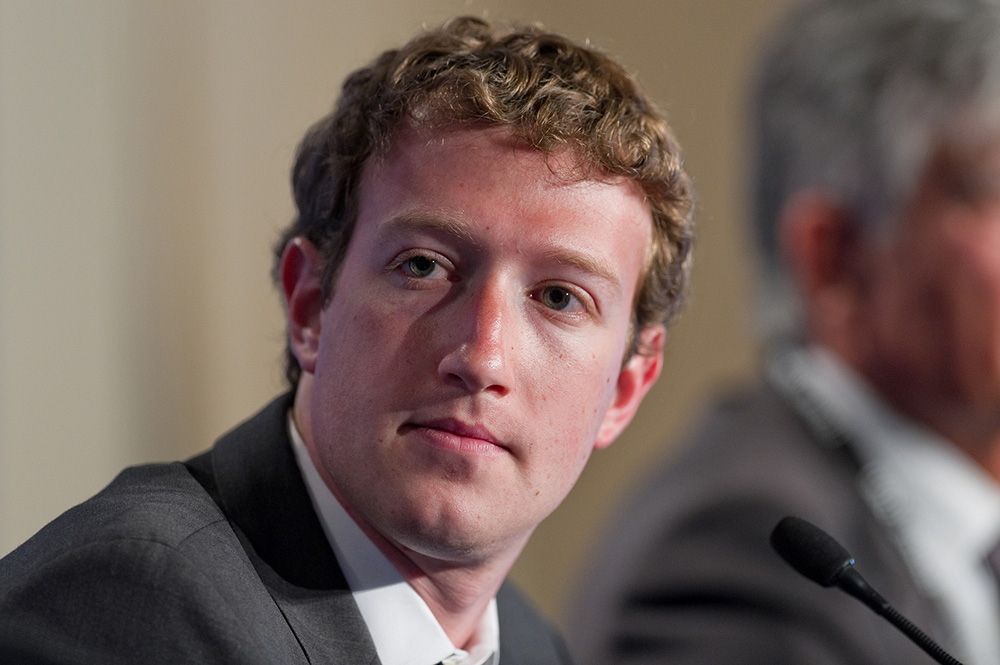

During a Senate Judiciary hearing in October 2020, Facebook CEO Mark Zuckerberg and Twitter CEO Jack Dorsey said that revoking Section 230 would “collapse how we communicate on the Internet.”
For example, if someone posts false information on their account, Facebook is not legally required to censor it. And on the flip side, if Facebook decides to remove a user’s post, it is not in violation of the First Amendment, thanks to Section 230.
“Section 230 was a move to help pioneering tech industry players to flourish — it was to encourage for-profit companies to keep developing creative solutions. It was not a move to bolster the First Amendment,” says Jenny Lee, an expert in regulatory issues for technology companies and a partner at the law firm Arent Fox, LLP. “The First Amendment or free speech right is a legal restriction on what government can do to consumers/citizens; it is not a mandate for private corporations to give privileges to citizens for free. Think of Twitter and Facebook as the baker and your social media wall as a gay wedding cake; it is the government — not a private company — that has obligations with respect to not infringing constituents’ free speech or constitutional rights.”
But social media sites are not the only ones that fall under the Section 230 umbrella. Amazon and other e-commerce retailers have leaned on the protections Section 230 provides as it relates to third-party sellers on their sites. In 2014, a woman was walking her dog with a collar she had bought from Amazon when the collar snapped and left her permanently blind in one eye. The woman attempted to sue Amazon on the grounds of negligence, but under Section 230, Amazon could not be held accountable, since the product came from someone using their platform, and not from them directly.
Section 230 has come into the spotlight more recently, however, due to the vast amount of anti-vaccine misinformation being spread on social media platforms (remember last year’s wild rumor that 5G and microchips cause COVID?). President Joe Biden even went as far to say that Section 230 is “killing people,” during a July press conference. But big tech companies seem to think that the law is doing more good than harm.
During a Senate Judiciary hearing in October 2020, Facebook CEO Mark Zuckerberg and Twitter CEO Jack Dorsey said that revoking Section 230 would “collapse how we communicate on the Internet.”
For instance, some social media companies may become hyper-vigilant on what they allow to be posted on their platforms, for fear of being sued. Retailers, on the other hand, may limit or end their relationships with third-parties because of the additional risks they create around misinformation. With third-party sellers making up 60 percent of Amazon’s total sales, it could make a huge dent in many an e-commerce business model. Right now, the sellers have a lot of freedom to say what they want about their products, but Amazon would have to crack down on that if the law was revoked.
What’s more, for Facebook to monitor what is posted on its platforms would not be unlike what traditional editorial publications and newspapers, which more easily face libel lawsuits as publishers, have had to do for years. Since Facebook makes money off the ads — many from retailers and e-commerce players — that run next to all this misinformation, many argue that it is essentially monetizing curated information and that it must be just as vigilant as a newspaper or magazine.
For better or worse, things may change soon. The effects of changing or revoking Section 230 would be felt immediately and significantly across the entire Internet, including the retail sector specifically. With the amount of vaccine misinformation spreading like wildfire, a decision on Section 230 is likely impending.
No matter how the decision on Section 230 plays out, retailers should take a hard look at their social media guidelines, and also ensure that any third parties that use or sell products on their platform are conducting best practices; because if not, everyone could lose.
3D COMMERCE
Building Blocks of a Virtual Inventory
3D models of retail goods are one of the most powerful e-commerce tools to emerge in the past decade. Here’s why.
BY SHRENIK SADALGI, 3D Commerce Working Group Chair,
The Khronos Group, and Director of R&D, Wayfair
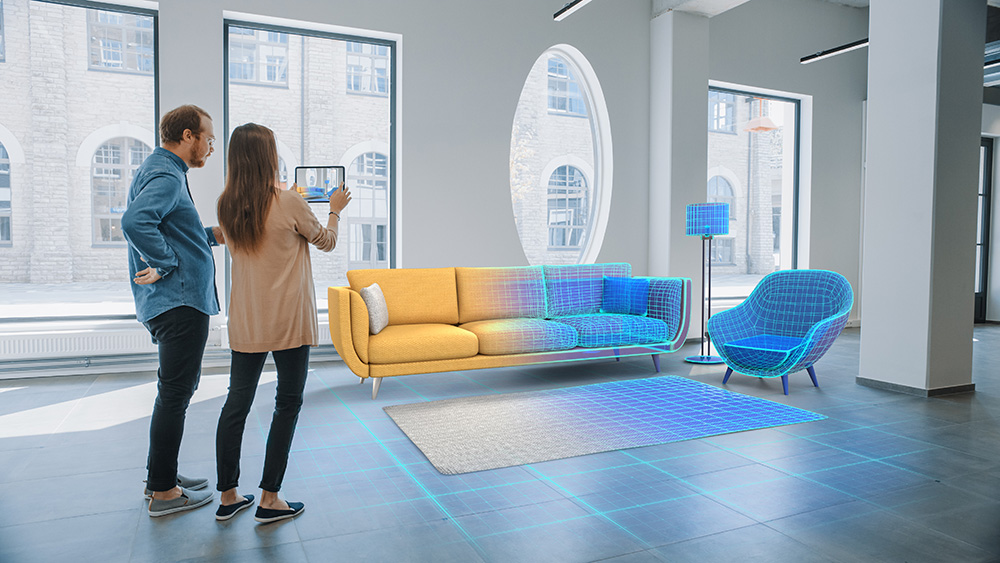

One of the most powerful e-commerce tools to gain traction in the past decade is interactive 3D modeling of virtual goods: Think 3D sneakers that can be viewed from multiple angles and in different colorways, or furniture consumers can “view in room” through an Augmented Reality (AR) app.
Retail sales have grown by almost four percent annually since 2010 [1]. During that time, e-commerce penetration has increased more than sixfold [2], as more and more platforms have built exceptional shopping experiences online.
Today, an online presence with a user-friendly storefront and beautiful, detailed product imagery is table stakes for any retailer, regardless of size. Independent retailers and big brands alike need to be able to provide first-class online shopping experiences. Retailers are exploring emerging technologies to refine and reimagine what shopping for their category looks like online. One of the most powerful e-commerce tools to gain traction in the past decade is interactive 3D modeling of virtual goods: Think 3D sneakers that can be viewed from multiple angles and in different colorways, or furniture consumers can “view in room” through an Augmented Reality (AR) app. This space holds so much potential that some of the biggest names in e-commerce, such as Wayfair and Shopify, have come together with companies across the technology spectrum to form a coalition. More than 80 companies are working together to enable the seamless design, manufacture, and presentation of 3D products, so that retailers of all sizes can better use this technology to deliver online experiences.
3D virtual products may one day accompany every product listing, together with the traditional 2D images. These digital assets can be enormously effective sales drivers. For example, Shopify began allowing merchants to upload 3D assets and associate them with products in 2018. Now, this feature is available to over 1.7 million Shopify merchants. “We’ve seen products with 3D/AR content convert at a 94 percent higher rate than those with just images,” says Jon Wade, Sr. product manager for Shopify. “3D Models will be just as important as photography and videos in the coming years.”
Jatinder Kukreja, founder and CEO of SuperDNA, reinforces this view: “Around 30 percent of browsers will make an impulsive buying decision if they interface with true-to-life product visuals on an online store. 3D and AR/VR solutions can fulfill the appetite for cutting-edge, high-end visual content.”



“Customers receive added convenience, a more engaging retail experience, and the ability to make a more informed purchasing decision, while retailers reap the benefits of cost savings, reduced inventory and showroom displays, and greater incentive driving potential customers to make purchases.”
“The industry has seen solid proof for the benefits with respect to key success metrics such as conversion rate and number of returns,” adds Max Limper, CTO, DGG (makers of RapidCompact). “The way we shop online is going to be enriched with 3D content more and more every day.”
3D models of e-commerce goods offer retailers operational benefits as well. Retailers don’t have to restage photoshoots of digital assets if a new colorway or material is released; the asset itself can be updated. These assets can also replace or supplement in-store displays, reducing shipping and inventory costs. “Advances in the modern retail experience benefit customers and retailers alike,” says Brent Scannell, product owner at Autodesk. “Customers receive added convenience, a more engaging retail experience, and the ability to make a more informed purchasing decision, while retailers reap the benefits of cost savings, reduced inventory and showroom displays, and greater incentive driving potential customers to make purchases.”
As early movers like Wayfair and Ikea experimented with ways to deploy 3D technology, the appetite for 3D content creation and platforms on which users could experience those models continued to grow. With retail, software, and hardware all sprinting to develop this technology, it became difficult to ensure cooperation across the design, manufacture, and presentation of products across multiple platforms at an increasingly enormous scale.
Then, in 2019, a group of retail companies came together and approached the Khronos Group to form a 3D Commerce Working Group focused on easing the friction in the 3D content development pipeline. The Khronos Group is a non-profit consortium, creating open, royalty-free interoperability standards for 3D graphics, virtual and augmented reality, and parallel computation. It was the natural home for this work, because it was already responsible for the creation of the glTF file format. glTF is the ‘JPEG of 3D’: a compact, easy-to-process format that can run on a wide variety of platforms including web browsers, mobile devices, PC desktops, and the cloud. This format is flexible; it can describe any 3D model from single objects to full scenes with animation; and it’s a pure asset format, which means it can be used by any type of software that uses 3D — including on the Web and in social applications.
The 3D Commerce Working Group brought together Khronos’s 3D engineering expertise with the new participants’ retail insights to optimize the process of deploying glTF for e-commerce. The group has made advancements to help retailers, artists, and 3D tool vendors. Khronos’ work directly benefits retailers through advancements like new extensions that enable more realistic glTF models, or programs that help ensure a more consistent display of glTF assets across different platforms. As retailers add 3D content to their storefronts, building new interactive experiences and engaging with or hiring artists to develop assets, they should develop familiarity with a few tools and concepts relating to the Khronos Group’s work.


“We’ve seen products with 3D/AR content convert at a 94 percent higher rate than those with just images,” says Jon Wade, Sr. product manager for Shopify.
Asset Creation Guidelines:
Many experienced 3D content developers aren’t familiar with the specific requirements of e-commerce. The 3D Commerce Working Group created a set of real-time asset creation guidelines that provide best practices for creating 3D models for cross-platform delivery. Using these guidelines, artists can produce assets that work equally well in a digital storefront, a native app, and a social media ad. The guidelines are free and tool-agnostic.
Material Variant Support:
Many products come in a variety of materials and colors. Material variant support makes it possible to combine these different options in a single glTF asset. 3D files are not small. Having to download multiple versions of the same asset to view different style options can lead to increased memory usage and slower interactivity. Packaging variants in a single asset using material variant support results in a better consumer experience.
Physically Based Rendering (PBR):
PBR is an approach to 3D rendering that creates realistic results by modeling the physical properties of real-world objects: how soft, shiny, reflective, translucent, etc., the material is in real life. Without PBR, 3D models can look sterile and uncanny. With PBR, 3D objects come to life, looking more appealing to consumers and giving them more accurate information about the potential purchase. The Khronos Group’s 3D Formats Working group has been cooperating with the 3D Commerce Working Group to develop the PBR extensions most urgently needed by the e-commerce community. This work enables the creation of photorealistic assets that can be displayed in any context, including virtual product photoshoots.
3D models of e-commerce goods offer retailers operational benefits as well. Retailers don’t have to restage photoshoots of digital assets if a new colorway or material is released; the asset itself can be updated. These assets can also replace or supplement in-store displays, reducing shipping and inventory costs.
KTX 2.0:
To provide the best consumer experience, retailers must balance image quality against file size and memory requirements. KTX 2.0 is a texture container format that helps thread that needle by offering compression that works universally across platforms. KTX 2.0 offers both high-fidelity and high-efficiency compression options. Retailers can work with content creators to select the right parameters for a beautiful 3D asset in a smoothly functioning experience.
Viewer Certification:
A glTF asset is created independently from the 3D viewer used to build a consumer experience. The viewer itself can have a major impact on what the consumer sees: the same asset might look very different in a digital storefront versus a mobile ad. The 3D Commerce Working Group recently launched a Viewer Certification Program to address this problem. The group is currently assessing a wide variety of popular viewers using a test pack of images, ensuring they render the test images the same way the baseline glTF Sample Viewer does. Certified viewers will be listed in a public certification registry. When building a digital storefront, selecting a certified viewer will help ensure the consistency of the experience.
Retailers can leverage these tools and resources to work closely with artists and content developers to build their digital inventory and online consumer experiences. The Khronos Group’s advancements mean more bang for the buck on each 3D asset. The Realtime Asset Creation Guidelines and material variant support extension mean that one glTF asset can do the work of many across platforms and applications. The universal glTF file format, made more photorealistic by PBR extensions and more compact by KTX 2.0, means retailers can commission great-looking assets that won’t bog down their digital storefront’s performance. The Viewer Certification program gives retailers confidence that the digital inventory they’ve invested in building will perform as expected in any context.
Most importantly, all of these guidelines are freely available, and these standards are open and royalty-free. The glTF file format is supported by just about every major 3D asset creation tool and display engine in the e-commerce space. This ubiquity means a truly level playing field. Independent retailers should stake their claim to this space now; opportunities are poised to grow. What today is a tool to drive sales and maximize efficiency may soon be crucial to maintaining customer relationships in an increasingly online retail landscape.
“The industry is in pursuit of innovative and interactive retail experiences that captivate and entertain consumers while shopping — and even after a purchase transaction is complete.” says Scannell. “While the challenges of today are about delivering a compelling and convincing representation of the product, the challenges of tomorrow will focus on differentiation through memorable marketing and retail experiences.”
SUMMARY:
- 3D models of retail goods are one of the most powerful e-commerce tools to emerge in the past decade, boosting sales, decreasing returns, and reducing inventory requirements.
- The glTF file format, known as the ‘JPEG of 3D,’ has become the center of standards development activity to make the 3D commerce asset development process more streamlined.
- The Khronos Group’s 3D Formats and 3D Commerce Working Groups have developed tools, programs, and file format extensions that retailers and their partners can leverage to create cross-platform assets.


3D glTF model of olives under a glass dome using the IOR, Specular, Transmission, and Volume PBR extensions to add reflection and refraction to translucent materials. Rendered in the raytracer Dassault Systèmes Enterprise PBR Sample Renderer. Model copyright 2021 Wayfair LLC, CC BY 4.0.


WARRANTY ROUNDUP
Protection in Pandemic Times
COMPILED BY NANCY KLOSEK


The year 2021 has been one of many moving parts in the consumer technology business, affecting both retailers and their supply chains due to chip shortages and other, cascading effects that have flowed from this situation.
How has your warranty business been affected by these circumstances, and what are your business strategies to address dealers’ needs at this time?


AIG | Chrisie Dorton,
Vice President of National Accounts
While consumer product and warranty purchasing behavior shifted from in-store to digital, AIG continued to support our clients by sharing proven online sales approaches tactics and working closely with our partners on underwriting adjustments. We also increased staffing to handle higher call volumes and to help customers understand the nature of any service delays, including those caused by parts shortages…


ALLSTATE PROTECTION PLANS/SQUARETRADE |
Wini Hebalkar, Senior VP, Operations
The challenges of COVID did affect the repair side of our business. Chip and component shortages meant parts were scarce, while social distancing protocols limited in-home repair technicians’ ability to interact with customers. To minimize the impact, we worked with supply-chain partners to explore alternative sources, ensure capacity, and increase parts inventory levels.
For our customers, communication was critical. We made sure they understood potential constraints and we offered alternative service options when available. During these unprecedented times, our customers were amazing — understanding and appreciating our honest efforts.
Though challenges continue in 2021, our preparation and investment in the customer experience and service network design mean our customers and partners should be insulated from the worst effects of this pandemic-triggered supply constraint moving forward.


ARCH INSURANCE GROUP |
Brian J. Olson, VP, Arch Warranty and Lender Solutions (AWLS)
Being a warranty insurer / obligor for both the consumer electronics and passenger vehicle markets, we benefit from seeing multiple approaches to the chip shortage. Taking observations from the automotive space, we see large numbers of dealers taking one of two approaches: Cut advertising costs to save expense since demand for vehicles remains high, or go all in on advertising dollars and ensure buyers arrive at their front door.
Neither approach changes supply-chain issues (although vehicle sales generally result in trade-ins, creating more used inventory); one need remains constant — maximize profit from limited opportunities while enabling an excellent customer experience. Extended protection options provide just this. Our highest priorities at AWLS are providing superior consumer-friendly coverage options, with the most flexibility for profit, while maintaining the highest legal, regulatory, and ethical standards.


ASSURANT |
Jeff Unterreiner, President, U.S. Connected Living
Supply-chain issues and an increased reliance on connected products has made the customer experience even more important to brand loyalty. Consumers want support and protection to keep their products running smoothly for longer. Assurant’s research shows that 70 percent of consumers would be more likely to purchase a connected product if also offered protection and support services. Preference for on-demand tech support saw a 44 percent jump from 2019 to 2021. In this environment, Assurant continues to team with our retail partners to deliver premium experiences by making it easier for customers to install, connect, use, repair, and upgrade their products regardless of channel.


ASURION |
Rob DiRocco, Senior VP of Client Services and Sales
As a tech care company, Asurion’s priority is to keep customers connected through repair, replacement and support services.
Our services provided by Asurion and tech repair retailer uBreakiFix by Asurion are even more relevant today, given the higher prices and scarcity of some devices that the chip shortage has created. Fortunately, we haven’t been significantly impacted by the chip shortage, largely due to our strong relationships with manufacturers and parts suppliers. Our clients can also benefit from our network of nearly 700 uBreakiFix by Asurion stores to help their customers get fast, local repairs during a time when purchasing a new device may be difficult, due to cost or lack of availability.


CENTRICITY |
Chris Penn, Vice President, Client Services
2021 has certainly brought about unprecedented supply-chain issues, and Centricity has worked closely with our retail partners to mitigate the impact to the end consumer. High demand and low supply have increased the time to repair and replace products, and costs have risen, most notably in the appliance space. We’ve found creative ways to help customers, such as amped-up loaner programs where available and providing mini fridges and cooktops to bridge the gap while they wait for service or replacements. To diminish the effects of the delays, we’ve also increased communication touchpoints to keep customers up to date on the status of their claim and available options.


CLYDE |
Brandon Gell, CEO
The supply-chain issues currently impacting the consumer technology industry have created unique opportunities for our business. With logjams at ports, chips are largely unavailable for a wide array of products, which has severely limited retailers’ capability to offer replacements for damaged or defective products. As a business, we help retailers extend repair options to consumers in lieu of shipping new products, flexibility that is infinitely more attractive to consumers hoping for quick resolutions. This multifaceted response has afforded the retailers we work with peace of mind as supply-chain issues persist.
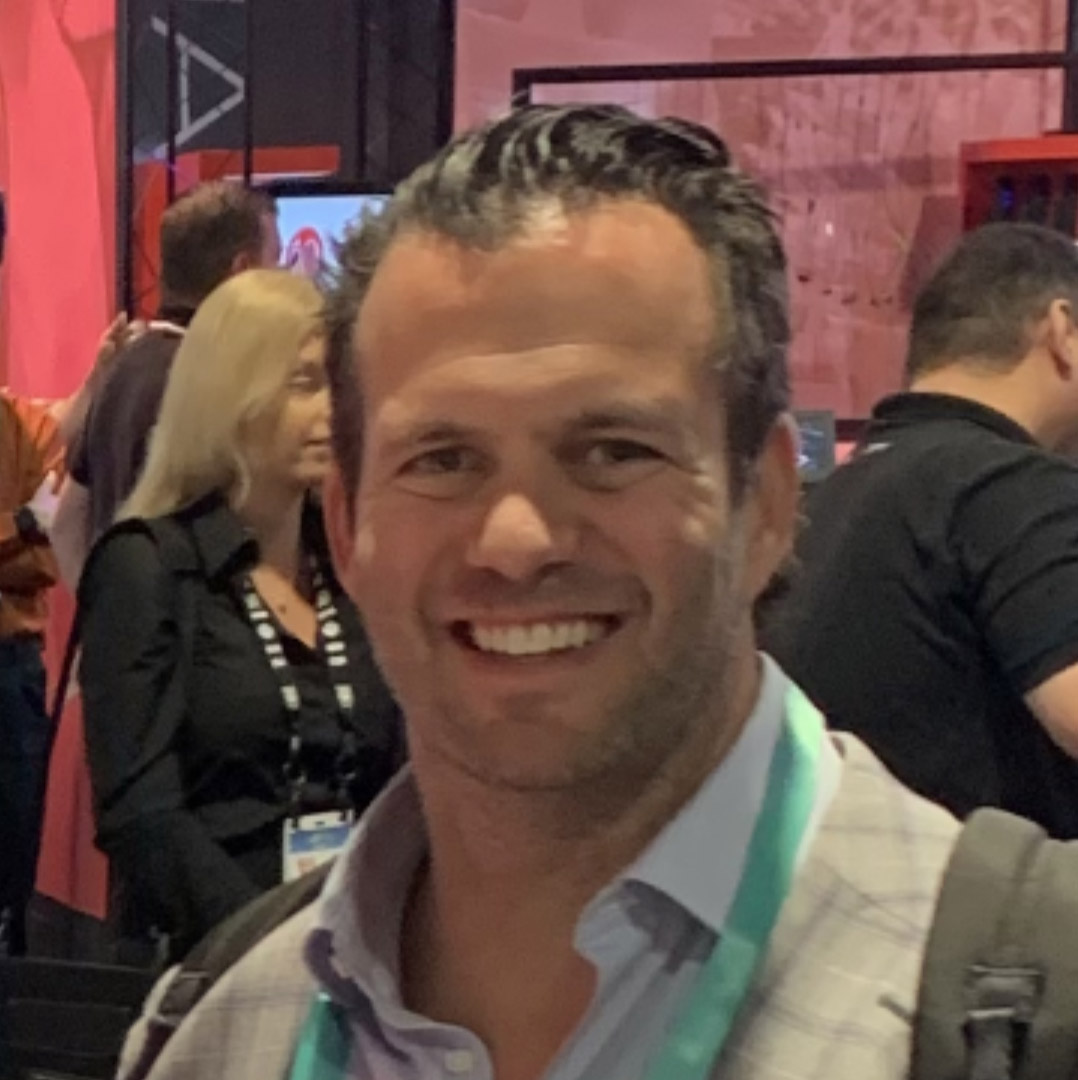

EXTEND |
Woodrow H. Levin, CEO
COVID-19 dealt a massive blow to consumer technology businesses and operations. During the past year, manufacturers have faced significant supply-chain disruptions and shortages. As a result, manufacturers are under pressure to meet unprecedented demand and high customer expectations.
Extend is helping alleviate pressure by offering modern product protection services that keep merchants’ customers connected to their products longer. Our API-first solution helps merchants get activated quickly so they can focus on solving supply-chain challenges. Extend takes that major pain point off merchants’ plates by handling offer optimization, claims adjudication and providing a seamless end-to-end customer experience. At Extend, we’re investing in machine learning to expedite services, streamline customer claims and help merchants maximize their revenue, satisfying merchants and customers throughout the entire journey.


FORTEGRA |
Leigh Mascherin, Vice President of U.S. Warranty Sales
Seeing obstacles as opportunities is one of our company values, but the last 18 months have put that motto to the test. We were challenged first with COVID and now, the chip shortage. Thankfully, our culture is very entrepreneurial for a large company, so we’ve been able to adapt quickly.
With the supply-chain challenges, service contracts have become a vital part of the retail business model. They provide valuable peace of mind to consumers looking for ways to extend the life of their electronics. And for the retailers, warranty solutions supplement lost revenue. We solved these needs with a second-chance program that offers retailers the opportunity to sell service contracts on prior purchases.


GUARDSMAN |
Kerry Lawless, Vice President of Sales
At Guardsman, we understand our retail partners’ challenges and offer solutions to help maximize our partners’ profitability. We have created solutions that drive post-purchase programs, enhance cash flow, support expanded payment terms and extended our current product offerings to give our retail partners more tools. Our Number One priority is to support our retail partners and ensure consumer interaction as an opportunity to drive loyalty to our partners’ brand.


MACK WORLDWIDE WARRANTY |
Jennifer Monasterio, President
2021 will be remembered as the year of the product pandemic. The words “less” and “more” will be in remembrance of CE folklore. Less encompasses a product’s complete life cycle. We are combating less products, less parts for repairs, less retailers to purchase from, less product selection. More represents the increased costs across the board for consumers, retailers and manufacturers. Product obsolescence is now at an all-time high. Consumers cannot afford not to protect their investments. Retailers need more than warranties to sell for solely increased profits. Warranty programs need to drive the customer experience so that the end result will be retaining customers for the retailer.


NEW LEAF SERVICE CONTRACTS |
Kharl Mena, VP, Business Development and Client Services
After over a year at home, Americans have been relying more than ever on major appliances and consumer electronics, creating a need to replace these larger-ticket items sooner than the products’ anticipated life expectancy. This has created a positive effect on clients’ sales of product and extended service contracts. The increased demand for new products combined with the pandemic-related challenges created a significant strain on the supply chain and the overall availability of parts to repair existing product. New Leaf recognized this early on and proactively adjusted our processes to procure parts by increasing the number of team members focused on locating parts, and leveraging our extensive OEM relationships to expedite parts directly to our service providers or customers’ homes. New Leaf’s efforts have had a positive impact in reducing repair times and improved customer experience.


ONPOINT WARRANTY |
Chris Smith, Chief Service Avenger
Product and part shortages have really impacted dealers and the warranty companies that serve them. Traditionally, if a product could not be repaired due to economics or lack of parts, we would replace with a like product from the same brand. With product shortages, we have done more cash reimbursements, allowing the consumer to pick what is available today. There is also a shortage of technicians to do work; with our Bounce program, a consumer can find their own servicer and get reimbursed within 24 hours via PayPal or Venmo. We are always trying innovative ways to improve the customer experience and help our dealer partners.


PERSONAL SAFEGUARDS GROUP |
Michael Frosch, President
The service contract business has continued to experience strong growth in attach rates in 2021 as retailers and OEMs have focused on how to better serve their customers. Personal Safeguards Group (PSG) has focused on new program offerings and structures to help drive the attach rate growth and provide product differentiation. PSG clients have launched subscription-based monthly programs, extended their standard factory warranty on a promotional basis and taken out costs by working directly with licensed providers while retaining the customer experience elements. It’s never been easier to take control of your service contract program and the impact it has on your customers.


PROTECTALL |
Michele Gloeckler, Vice President of Sales
Over a year after the 2020 pandemic hit, we are still feeling the cascading effects continuing to impact suppliers, retailers, and consumers everywhere. From raw material and container shortages to increased pricing and supply delays, manufacturers are still struggling to meet demands. While this highly elevated level of consumer spending was driven primarily by quarantine, it was also driven by the new remote way of living. The need for electronics in the home has skyrocketed, and despite the unemployment rate and fading government stimulus, the U.S. Census Bureau still shows a 90 percent increase in electronics and appliance sales. So, while the industry may still have supply and demand challenges, consumer spending is strong, profits are up, and protection plans are still a major focus for retailers. Therefore, we are expanding our strategic training efforts, growing our e-commerce partners, utilizing portals to meet demands, and still providing outstanding customer service.


AUDIO-VIDEO
Five Things to Know About 8K
Before you or your customers take the plunge into the hot new high resolution, it’s best to understand what it currently can and cannot do.
By Vanessa Zitzmann
Although I have been working in the AV industry for close to eight years, I still consider myself a consumer, not an expert, on AV technology. I know just enough not to take every new piece of tech at face value, or believe the hype from product marketing. This is where we as consumers or AV integrators need to make sure we’re educated, and not basing our purchases solely on what the sellers of the technology have told us. Sometimes what has been marketed is not always complete, accurate, or obtainable. It could be exaggerated specifications, glossing over of known glitches, shortcomings, or usage cases that are virtually impossible to recreate. It is important to get through all the marketing fluff and get to the meat of the technology. It’s also important to understand why a new technology is better, as well as where and if it fits into our homes and installations — all while educating ourselves in understanding the inherent weaknesses that every piece of technology has.
With 8K visible everywhere and the full marketing push behind it, I’ve had some burning questions for my industry peers, and wanted some guidance on this technology and its future that I can share with the retail and CE professionals who read Dealerscope. Based on my conversations with engineers, manufacturers, salespeople, installers, and retailers, here is some of the information that I put together on this new 8K industry trend.
The bigger the screen and further viewing distance, the better the 8K will look to you. This suggests that projectors may be the way to go to create visible 8K benefits at home.
Only early adopters need apply.
When 4K was introduced to the custom integrator (CI) channel in 2013, 4K, at its best, could only support 4K/30Hz with 4:4:4, 8-bit HDR at 10.2 Gbps. While this was vastly superior to 1080p, the true benefits of 4K came from the embedded 10-bit HDR (High Dynamic Range) metadata. In order to support HDR-10, compression had to be added; the existing infrastructure couldn’t support 18 Gbps because category cables (CAT6a) maxed out at 10.2 Gbps. Remember that when you invest in anything 8K; we’re still at the beginning of the technology and what is possible remains limited. Take all the promises and hype with a grain of salt!
It’s all about the bandwidth.
Having a solid understanding of the bandwidth calculations of 8K and what 8K brings to the table is vital before investing or upgrading from current 4K products. True 8K requires significantly more bandwidth than its 4K counterpart. 8K products need to be able to support the minimum of 32.08 Gbps for 8K 30 Hz at 4:2:0, or, for full 8K 60 Hz 4:4:4, 80.19 Gbps is required. 8K/HDMI 2.1 also encompasses many benefits outside of resolution such as eARC, Fixed Rate Link, Auto Low Latency Mode, and Variable Refresh Rate, to name a few. Still, bandwidth must be looked at as a whole and depends on various factors from cable quality to broadband speed (for streaming). 40 Gbps for 8K is just a stepping stone for what is to come as we grow the technology. The HDMI.org website is a good source for the various factors that affect bandwidth.
Wait for updated chipsets.
In a rush to be first to market, many manufacturers have jumped on the “8K” bandwagon, but they’re doing so without testing equipment in real-world environments. As a result, most 8K products hitting the market today are only able to support up to 40 Gbps. They are finding out the hard way that the products they designed are not compatible with the actual sources. The experts I discussed this with don’t feel the current chip sets can deliver on the promises of true 8K. They’re waiting for the technology to reach a minimum of 48 Gbps (HDMI 2.1) before feeling secure in introducing 8K products to market.
Content in 8K is still minimal.
Right now, there isn’t much 8K content, which isn’t surprising considering that even true 4K content (with a horizontal resolution of 4,096 pixels) isn’t as widespread as we’d expect, considering the broad availability of 4K televisions and projectors. That said, 8K is available in limited ways, and the best way to get that 8K content at the moment will be through streaming. Sporting events in some regions (mainly Japan) are broadcasting live events in 8K, YouTube has some 8K videos created by its users, and both PlayStation 5 and Xbox Series X offer 8K gaming. I see the biggest opportunity for 8K being in live events at sports stadiums and concert venues.
The visual benefits of 8K are best experienced on gargantuan screens.
Can the human eye even see 8K? Yes AND no. 8K gives four times the horizontal and vertical resolution of 1080p and resolution does matter. However, to really make full use of 8K, you need to consider the screen size and viewing distance. For an average viewer with 20/20 vision sitting 10 feet away from the screen, to be able to see a visible difference between 4K and 8K, the screen should be around 280 inches! The bigger the screen and further viewing distance, the better the 8K will look to you. This suggests that projectors may be the way to go to create visible 8K benefits at home. It also creates huge opportunities for 8K in live events, sports stadiums, and concert venues. 8K is breathtaking with large displays, even with viewers sitting far away. Personally, I’m ready to go sit at Fenway Park (apologies to any Yankees fans) in my normal nosebleed seats and look out to the stadium displays showcasing my favorite team in 8K popping off the screen.
Now that technology has reached the 8K benchmark, it’s important for both retailers and consumers to make educated decisions about buying and selling. Understanding the technology is the best way to ensure you get all the benefits that 8K can currently provide.


UNBOXED
E-Bikes Go Full Throttle
Sales continue to climb for these tech-infused two-wheelers. It’s no surprise since they’re not only fun, but good for you, too.
BY JOHN R. QUAIN
Before the pandemic, e-bikes had taken Europe by storm and were set to make a splash in the U.S. Then COVID-19 pushed the battery-assisted two-wheelers to the fore as people shunned public transportation and looked for alternatives. E-bikes were the perfect antidote.
According to The NDP Group, e-bike sales in April 2020 rose by 92 percent compared to the previous year. And the trend has not ebbed. NPD also reports that by April 2021, e-bike sales were up by 139 percent to $681 million for the year to date compared to 2020. Clearly, consumers are interested in e-bikes.
Furthermore, it’s not just sales that have ballooned. Whether they become owners or not, people are riding e-bikes more. E-bikes are now a staple in rentals in both mountain bike and city tourist models, as well as in the budding bike-share market. According to an NBC News survey of bike-share programs in 11 cities across the U.S., e-bike ridership tripled from May 2020 to May 2021. Last year, e-bikes accounted for only 11 percent of bike-share rides in the surveyed cities with 240,000 e-bike rides. This year, e-bikes accounted for 38 percent of bike-share rides with 1.4 million trips.
Many purists have resisted the trend, complaining that e-bikes don’t offer the same health and physical benefits as traditional bicycles. However, with many models, riders still have to pedal. So-called Class 1 e-bikes only provide assistance (at user set levels) when the rider pedals, up to a top speed of 20 mph. Class 2 e-bikes add a throttle option, for full electric power, but again are limited to 20 mph. Class 3 bikes have a top speed of 28 mph but are intended mainly for off-road use.


According to a study published in the Translational Journal of the American College of Sports Medicine, comparing e-bikes to traditional analog bicycles, the electric counterparts still imparted some health benefits. Even riders on the battery assisted bikes got a significant workout, elevating their breathing and heart rates.
Nevertheless, according to a study published in the Translational Journal of the American College of Sports Medicine, comparing e-bikes to traditional analog bicycles, the electric counterparts still imparted some health benefits. Even riders on the battery assisted bikes got a significant workout, elevating their breathing and heart rates.
Best of all, e-bikes can give riders a health boost — without necessarily requiring expertise or a level of pre-existing fitness that scares some potential riders away. Retirees can confidently run errands and still make it over hill and dale, while workers returning to the office can take an e-bike and not arrive soaked in perspiration. It’s why many e-bike advocates call battery-boosted bikes the great leveler.
Now, there are e-bikes in every shape and size from mountain bikes to casual commuters. Here are three standout e-bikes we’ve tested that are aimed at different riders and price points.
Biktrix Stunner X:
Backroad Bruiser
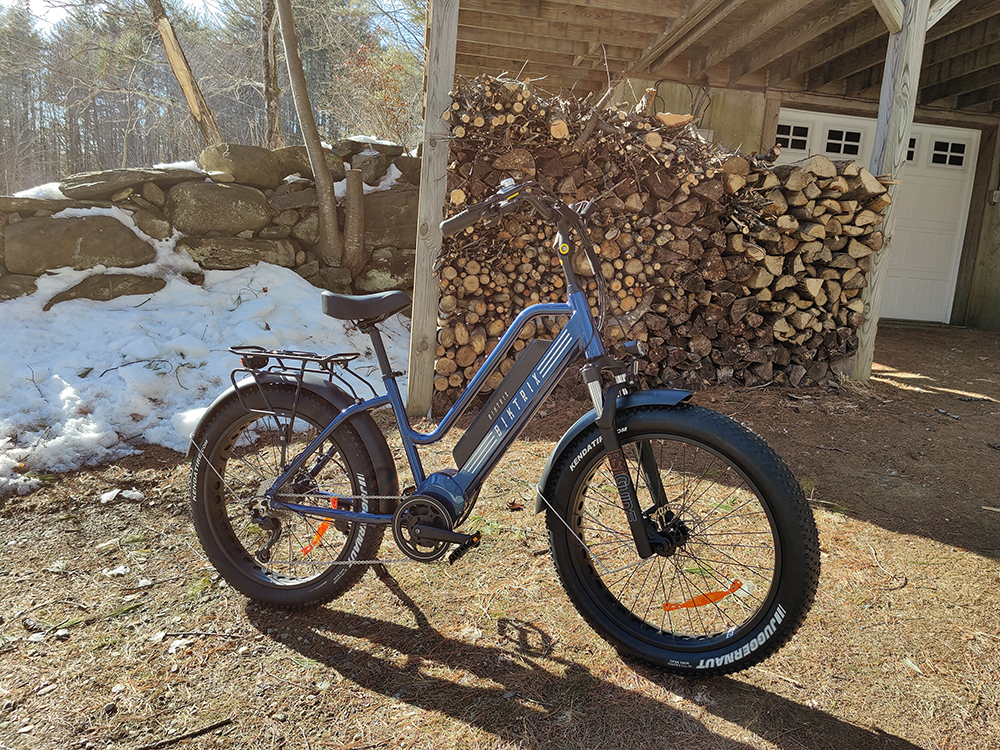

Price: $2,799 (starting price)
Battery: 840 Wh (as tested)
Max estimated range: 40 miles
Max assisted speed: 20 mph
Motor: Bafang 750w mid drive motor
Gearing: Shimano Alivio 9-speed
Wheel diameter: 26 inches
Weight: 65.8 pounds. (with large battery)
There are scores of newcomers to the market looking to capitalize on the e-bike craze, but Biktrix, a Canadian builder, has distinguished itself with a line of solidly constructed models designed to handle any weather.
With a commuter-like upright seating position, but power and components more typical of mountain bikes, the Stunner X can deal with mud, snow, or city streets peppered with potholes. It has enough of a kick to get riders up a gravel hill, and enough padding to prevent it from becoming a torture test. The Biktrix Stunner X uses a standard set of Shimano 9-speed gears, which is paired to a Bafang 750W mid-drive motor in the crankshaft. That makes for responsive electronic assistance, along with the large 1008 Wh battery to give it some extra oomph. To handle the rough stuff, the bike has Kenda Juggernaut 4-inch-wide fat tires and big aluminum fenders to keep the dirt off.
Subtle is not a word that comes to mind with the Biktrix Stunner X. When you first shove off, its initial electric boost can take you by surprise before you get your hands on the brakes. There are five levels of pedal assist, as well as a thumb throttle for full-on electric driving, restricted to a top speed of 20 mph. (Buyers can request that a bike be unrestricted for a top speed of 28 mph — but only for off-road use.) Fortunately, there’s plenty of power to get this 65-pound-plus bruiser to spin its tires in the mud, and it handles snow, gravel, and buckling pavement with aplomb. The only weakness — and something we’ve seen on many other bikes — is the Bafang controller, which can take some practice to learn how to do some basic things like turn the headlight on and off.
Gazelle Ultimate C380 HMB:
Comfortable Commuter
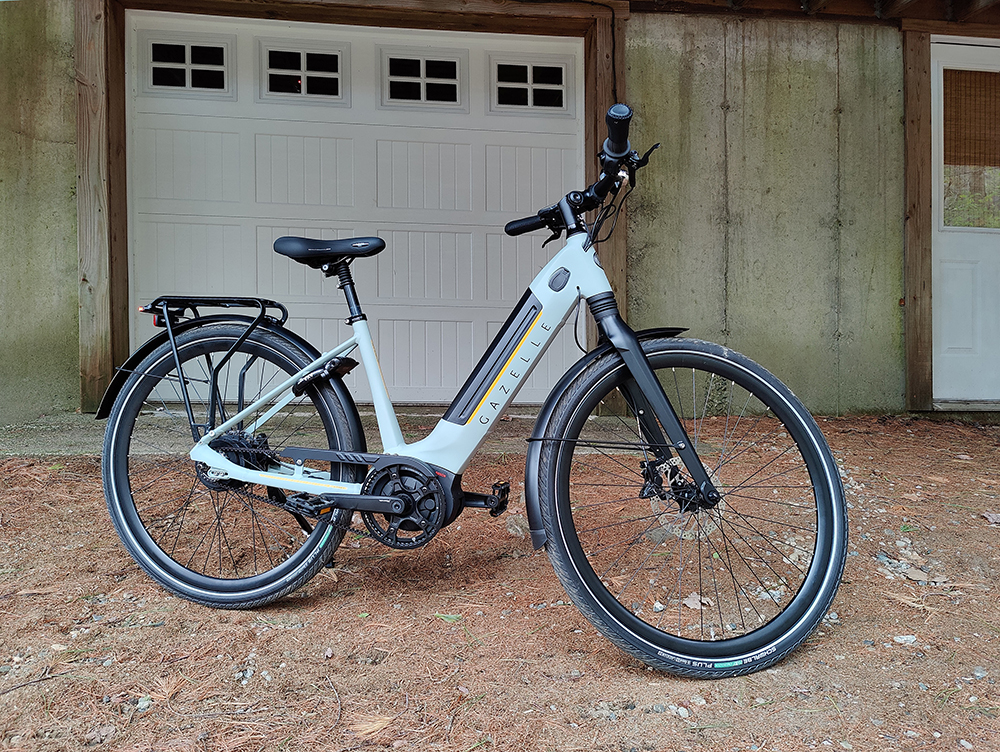

Price: $3,999
Battery: 500 Wh
Max estimated range: 43 miles
Max assisted speed: 20 mph
Motor: Bosch Performance Line 3.0 65 Nm mid-drive motor
Gearing: Enviolo 380 stepless gear system
Wheel diameter: 28 inches
Weight: 54.6 lbs. (with battery)
From The Netherlands, where bicycles dominate the cities and tulip fields, comes Gazelle’s Ultimate C380 HMB, a luxury bike with the most advanced — but subtle — technology that makes it a pleasure to ride.
Gazelle has been building bikes in the land of the bicycle for more than 125 years. And it has turned all of its experience and expertise to e-bikes. The Gazelle Ultimate C380 is a pedal-assist bike, meaning that it does not have an all-electric power throttle. The system uses a seamless Bosch mid-drive motor with a monochrome display that lets you cycle through four power modes: Eco, Touring, Sport, and Turbo. For comfort, the Ultimate C380 HMB uses a low-step frame topped with a Selle Loire Gel seat with an internal compression post to soften the ride.
Better still, Gazelle has made this model virtually maintenance-free. It uses a sealed rear hub with a continuous Enviolo Trekking shifter, so there are no gears or fussy derailleurs to tweak or worry about. And there’s no greasy chain to tighten. The Ultimate C380 employs a Gates belt drive that uses a carbon fiber reinforced notched belt instead. Over several weeks of testing, we found the seamless Enviolo shifter allows you to change gears in the middle of a hill, something that can damage a traditional derailleur, and the bike was smooth and stable in a variety of conditions, even going downhill at 30 mph. Throw in the built-in rear wheel lock to discourage thieves, and the Gazelle Ultimate C380 is the closest to worry-free biking you can get.
Charge Bikes City Electric Bike:
Best Bike in a Box
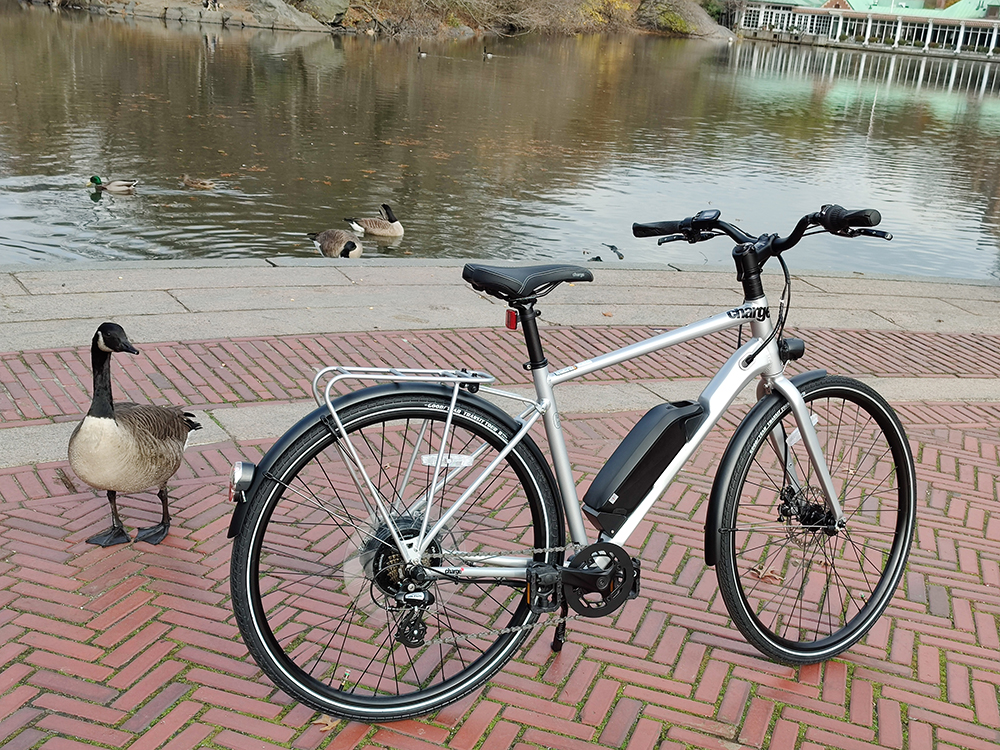

Price: $1,699
Battery: 418 Wh
Max estimated range: 50 miles
Max assisted speed: 20 mph
Motor: Bafang rear hub motor
Gearing: Shimano 7-speed
Wheel diameter: 28 inches
Weight: 45 lbs. (with battery)
Founded by folks from the popular biking brand Cannondale, Charge’s sui generis feature is that its bicycles have been specially designed for direct shipping to buyers. Yes, there are plenty of direct-to-consumer models now, but only Charge’s bike can be assembled by a beginner right out of the box in 10 minutes or less.
Pull apart the cardboard container (specifically designed to be easily undone) and all the buyer has to do is put the front wheel on and ride away. Better still, starting at $1,699, the Charge City Electric Bike is competitively priced and comes in both a low-step and a high-step model as well as two sizes, so it can comfortably accommodate riders from 5 feet 1 inch to 6 feet 3 inches. It works similarly to most e-bikes in pedal-assist mode, but also can go into full-throttle electric mode when needed.
In urban environs, the Charge City is surprisingly sure-footed for such a big bike. It handles well, whether you’re wending your way through stalled traffic or swerving around potholes. At higher speeds, it maintains its composure without oscillations or vibrations that would shake a rider’s confidence.
The bicycle’s aluminum frame and battery mean the Charge City Electric Bike tips the scales at 45 pounds — not the lightest but far from the heaviest e-bike if you’re hauling it up and down stairs. The pedals and handlebars fold flat, making it easier to store in an apartment or cubicle. All in all, this is an ideal commuter e-bike — at an ideal commuter price.
SMART HOME
The Modern Smart Home Is No Longer a Jetsons Fantasy
Highlights from the Parks Associates/GE
Appliances White Paper on the Connected Home.
BY MARK N. VENA, Senior Director, Parks Associates — Smart Home & Strategy Practice
It is a well-known truism that nothing succeeds like success. This maxim certainly applies to the modern smart home, where a new category of connected devices has been rapidly growing in adoption since 2014.


This phenomenon has not been accidental. Parks Associates data indicates that 88 percent of U.S. households currently have broadband access. The pervasiveness of broadband access in the typical household has created a fertile ground for connected devices. Parks reports that 34 percent of broadband households own at least one connected device, with consumers owning an average of 13 connected devices (of any type) in their home, up from 9.2 in 2016 — a dramatic 41 percent increase in less than five years.
Supercharging the smart home has been a rising desire by consumers to address and solve problems in the home. While the technical landscape of the smart home has been evolving (and continues to), new and existing homes must be “reimagined” with connected devices in mind.
Parks Associates recently engaged with GE Appliances to develop a white paper that identifies the opportunities, headwinds, triggers, and dynamics in addressing the macro smart home opportunity. Many of the white paper’s chief findings and insights conjure up a whole host of topics that smart home companies should heed in their mission to address this growing but challenging technology category.
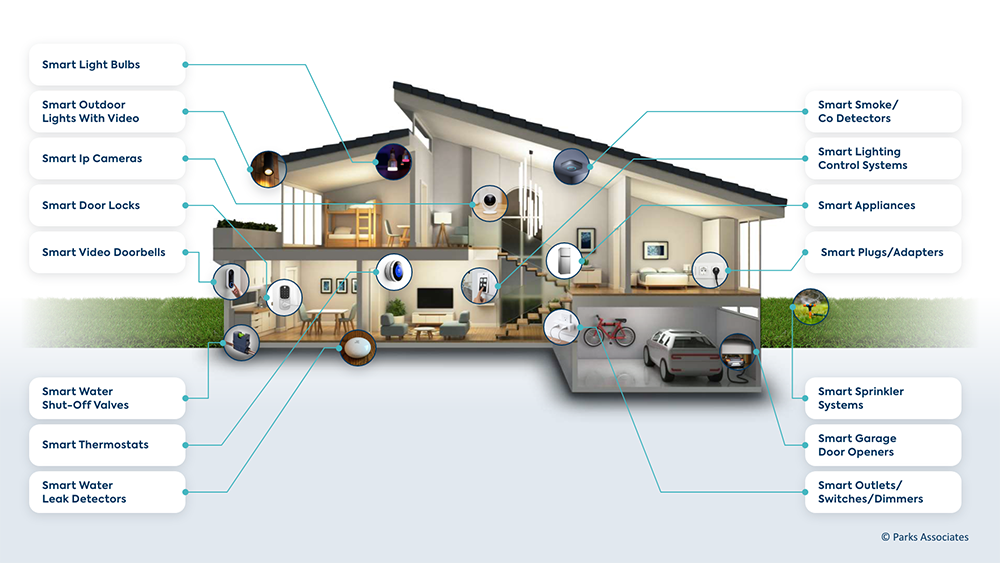

Smart home device demographics
Parks Associates’ research has identified convenience, comfort, and peace of mind as the central factors driving adoption. These primal factors have been abetted by traditional marketing attributes like increased brand/product awareness and co-marketing partnerships (particularly in legacy industries like energy providers, insurance companies, and energy providers). The smart home space, from its origin, has always had a DIY (Do-It-Yourself) guise, with the ensuing installation and setup consequences that early adopters and fast-follower consumers are willing to accept.
Nevertheless, the overall percentage of U.S. broadband households owning three or more smart home devices increased by more than 64 percent in the past two years, up from 14 percent in 2018 to 23 percent at the end of 2020.
It is hard to argue that COVID-19 has not played a central role in the scorching growth of video doorbells, as stay-at-home consumers (increasingly working from home) found unique appeal in the ability to monitor online deliveries and observe visitors to their homes, often in a remote manner. Parks data indicates that video doorbells experienced the highest growth level — up 86 percent over the past six years — of the most popular smart home devices. Contributing to the appeal of video doorbells, especially with the rise in crime in many urban and suburban areas around the United States, is the product’s ability to facilitate the overall safety of their neighborhoods by posting crime-solved videos of nefarious activity.
Interestingly, while smart thermostats did not relinquish their leading position for smart home devices before 2020, adoption growth for those devices is now at par with video doorbells. Smart light bulbs and smart cameras continue to remain relatively popular (the latter due to rising concerns about residential security). An increasing number of mainstream consumers recognize the remote monitoring value proposition and the ability to get notifications when homeowners are away.
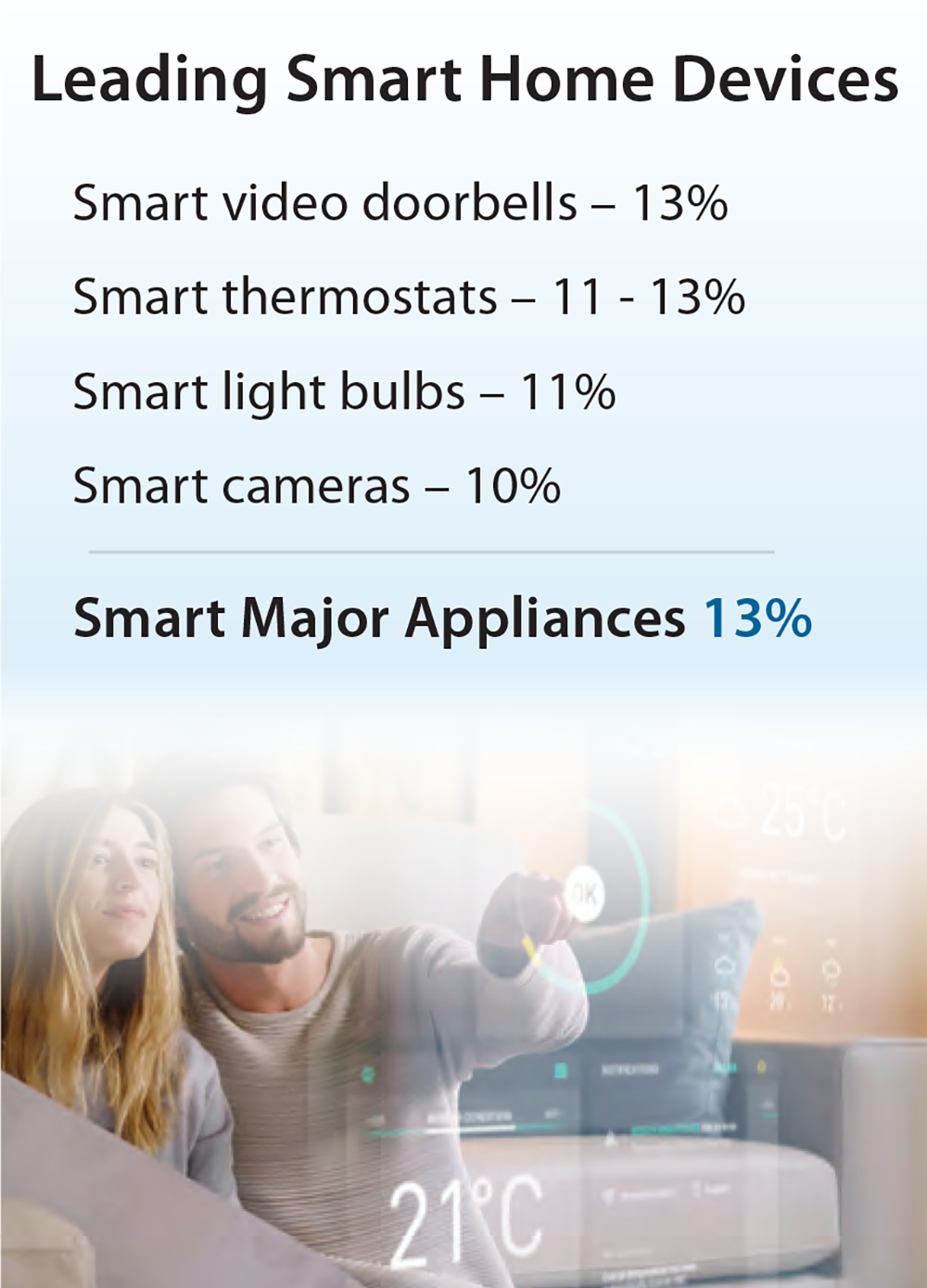



The top triggers driving smart home device purchases
Traditional product awareness continues to play a critical role that is fueling smart home device buying behavior. Smart home device visibility at brick-and-mortar retail stores, as well as online awareness, is the top purchase catalyst. Like many other technology-based products, smart home device buyers often look to other consumers’ experiences as a significant buying criteria factor.
Surprisingly, other traditional and customary marketing techniques like holiday specials/promotions, bundles, and other price-based incentives are somewhat influential, though not in the top consideration set as fundamental awareness and other’s people’s experiences are. This phenomenon could be explained by the average consumer’s desire to focus on real smart home problem solving rather than pricing or promotion “gimmicks” that are often effective with other types of products.


Smart home products imbue consumer lifestyles
Parks Associates’ research has underscored the epiphany that smart home and connected devices establish profound assimilations into consumers’ lifestyles. It is quickly becoming apparent that consumers are comprehending smart home devices in their domiciles and lifestyles in a manner so embedded it has become difficult for them to imagine what life was like before the dawn of the smart home era. It is not hyperbolic to state that smart home consumers are beginning to perceive video doorbells, intelligent thermostats, and smart light bulbs (just a few examples) as being as critical as “can’t live without” elements such as air conditioning, cell phone service, and indoor plumbing.
What are the key implications?
It is essential to point out that smart home and connected home devices have primarily been an early adopter phenomenon. This market condition is likely to change in the not-too-distant future as more mainstream consumers, often not technology-savvy, begin to comprehend and accept the benefits of the smart home value proposition. In addition, lower price points and integration of products, creating and enabling new value, will help increase adoption of connected products.
More compelling, impactful, and pragmatic marketing messaging can play a massive role in accelerating the appeal of the smart home. Consumers and households with modest (and less disposable) income levels are likely to adopt smart home technology only when they fully appreciate the usage model benefits. Home builders must comprehend the integration of these new technologies into their home design plans. Moreover, as 30 percent of U.S. broadband households live in MDU (multi-dwelling units), this is a clarion call for multi-family managers to integrate smart home capabilities into their properties to drive improved operational efficiencies through remote energy and access control management. For building management companies, the good news is MDU-based residents are willing to pay enhanced premium fees for smart home services and rentals that are smart home “friendly,” according to Parks’ research.
To learn more about new smart home products, the connected consumer lifestyle, and the future of modern living, download and view Parks Associates’ Smart Products: Building The Modern Home white paper.


2021 RETAIL EXCELLENCE AWARDS
Leaning In to Push Forward
Despite pandemic-era challenges, this year’s Retail Excellence Award winners evolved and grew over the past 12 months.
Dealerscope is excited to present the inspiring stories behind this year’s 2021 Retail Excellence Award honorees. This award is designed to recognize a select few independent retailers who demonstrated exceptional business performance and are leaders among their peers. Headlined by major shifts in the way traditional retailers do business, 2020–2021 has been a rollercoaster of a year. Our spotlighted honorees have risen to the challenges of the past 12 months and thrived by using creative and innovative solutions, which they have shared with us in the following profiles. Read on, to learn more about our outstanding honorees, and to get a glimpse into their respective successes during this unprecedented period.
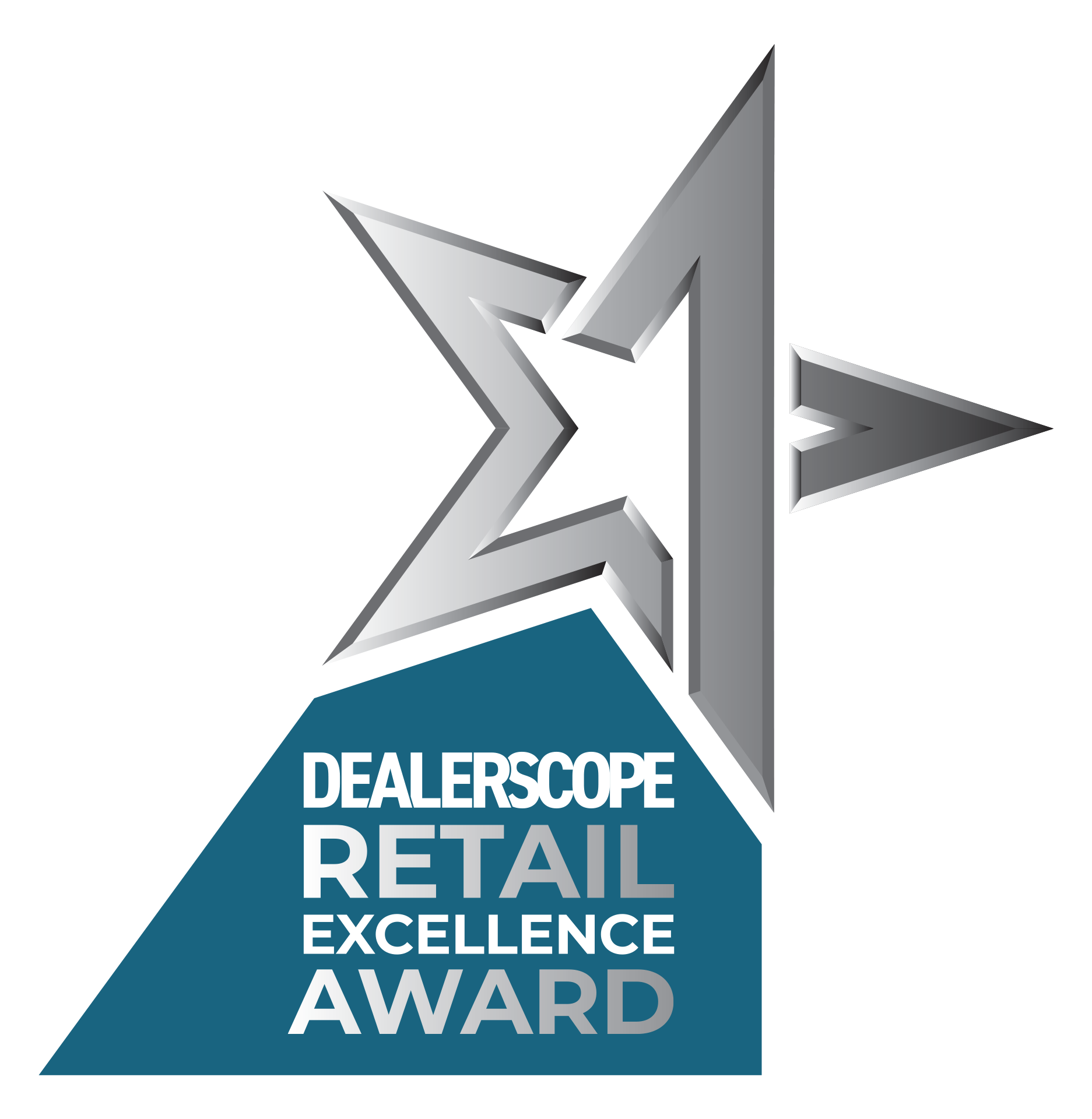



Ready for the New Travel Surge
How airport retailer InMotion made the most of its pandemic-induced “downtime”and emerged in major growth mode.
BY TOM SAMILJAN
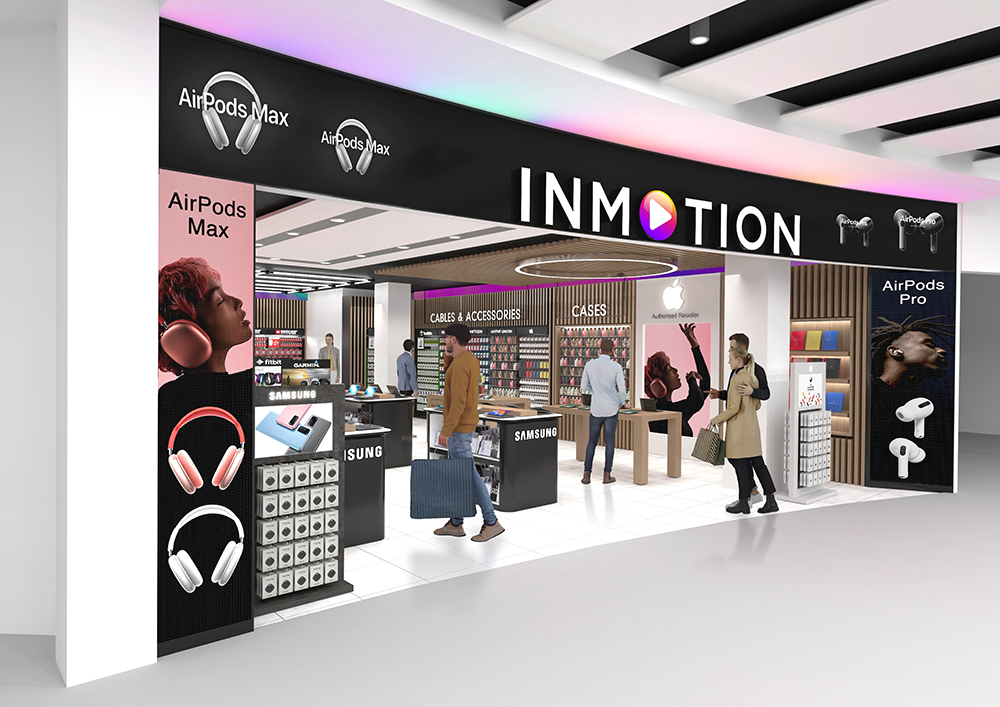

The pandemic was bad news for many retailers, but many of those who sold consumer electronics had the benefit of being designated essential businesses, which allowed them to remain open and sell all those video game consoles, laptops, and other stay-and-work-at-home tech that COVID-era consumers snapped up en masse.
Not so for stores located in airports, hotels, casinos, resorts, and other travel hubs. With air travel and hotel stays plummeting in 2020, it was a tough year for airport retailers, which suffered a 60 percent year-over-year drop from April of last year to April 2021, according to Coresight Research. Still, those travel retailers with deep pockets — and patient, visionary leaders — were able to lean into the pandemic, and are now poised to reap the benefits of a renewed interest in travel. (That same Coresight report estimates that airport retail sales will grow by $10 billion this year versus 2020.)
Case in point: InMotion, which sells everything from headphones and laptops to smartwatches and cable accessories to travelers in its 120 planeside stores, mostly in the United States and Canada. Though it had to close all of its stores in April 2020 for a couple of months, and even closed two stores for good in 2020, it is now in growth mode, replacing any shuttered outlets and then some with new locations.
Acquired by W.H. Smith in 2018, InMotion, which got its start in 1997 in Seattle and Minneapolis as an airport portable DVD “rent-tailer,” is now not only on a global expansion, but also moving beyond airports to hotels, resorts, and casinos. It helps, of course, that InMotion is a key part of parent company W.H. Smith’s airport retail strategy. Right before the pandemic, in late 2019, the British book and retail behemoth also purchased Marshall Retail Group (MRG), which operates more than 160 convenience stores in airports and hotels around the world. But instead of falling apart with what might have seemed like bad timing, W.H. Smith leaned into the comparative “downtime” of the pandemic and worked on fusing the two acquired businesses, while letting each focus on its respective strengths.
“Rarely do you get to work on a business when you’re not actually making sales,” Eden Goldberg, vice president of marketing and business development at InMotion Entertainment Group, told Dealerscope. “So we made use of this period to be very strategic and find best practices. We looked at our priority list of projects and actually got to them. This included everything from streamlining some operational processes to merging some of our shared departments with our sister company MRG. This didn’t only lead to cost efficiencies, but [also to] an overall stronger larger business. We’re also looking at a wider portfolio of retail solutions for many different travel shopping environments.”
The result? InMotion is not only supplying electronics inventory to existing MRG convenience stores, but is also expanding its brand into some existing MRG locations in hotels and casinos, including at the Forum Shops at Caesar’s Palace and Harrah’s in Las Vegas and the Seminole Hard Rock Casino in Fort Lauderdale. After all, travelers need headphones, speaker systems, action cameras, and cable accessories once they’ve arrived at their destinations as well as en route.
What’s more, the heretofore mostly U.S. InMotion brand is set to expand into additional international markets as well, with two new locations opening in Alicante, Spain and Berlin, Germany (as soon as that city’s new international airport is completed). And in July, the company announced that it would be opening stores in 18 airport locations throughout the U.K,, including Heathrow and Manchester, that were recently vacated by Dixons Travel Stores. This is hardly a retailer that is surrendering after a tough year.


Besides the overt expansions into new markets, InMotion has evolved with a changing customer base. Younger leisure travelers on a budget and a broader spectrum of work-from-home travelers have grown in number, so the stores no longer cater only to business travelers with premium tech needs and the financial wherewithal to acquire it. So, in addition to the requisite mice, portable keyboards, and laser pointers, InMotion has moved into more entry-level earbud and headphone categories, as well as health and wellness wearables such as portable air purifiers, percussive massagers, Apple Watches, FitBits, and more.
Since travel consumers have specific needs, InMotion has capitalized on bundling beyond specific products. So instead of just selling someone a Bluetooth headphone, InMotion’s salespeople are trained to educate consumers that they’ll also need a traditional audio cable or Bluetooth transmitter to use the airplane’s in-flight entertainment system. “We’ve really gone beyond not just qualifying the consumer’s need for the trip, but to finding an all-in-one solution for each customer,” says Goldberg.
It’s not quite an upsell, however. Educating and making tech easier for travelers has always been in InMotion’s DNA. “So many of the products we carry are unboxed, charged up, and ready to be used,” says Goldberg. “If we sell you a tablet or an Apple Watch, we’ll set it up for you with the right band and charger and insert a SIM card for you. If you buy a GoPro, let us at least teach you the 101 so that you don’t have to sit there with the instruction guide and hope you can figure it out on your tray table. That’s also part of the solution-based concept we offer.”
As with so many a lasting brick-and-mortar store in today’s increasingly omnichannel environment, InMotion’s secret to retail excellence often boils down to old-fashioned customer service.
For more, read our full interview with InMotion’s managing director and SVP, Pete Newbould, and VP of marketing and development, Eden Goldberg, under the Travel tab.
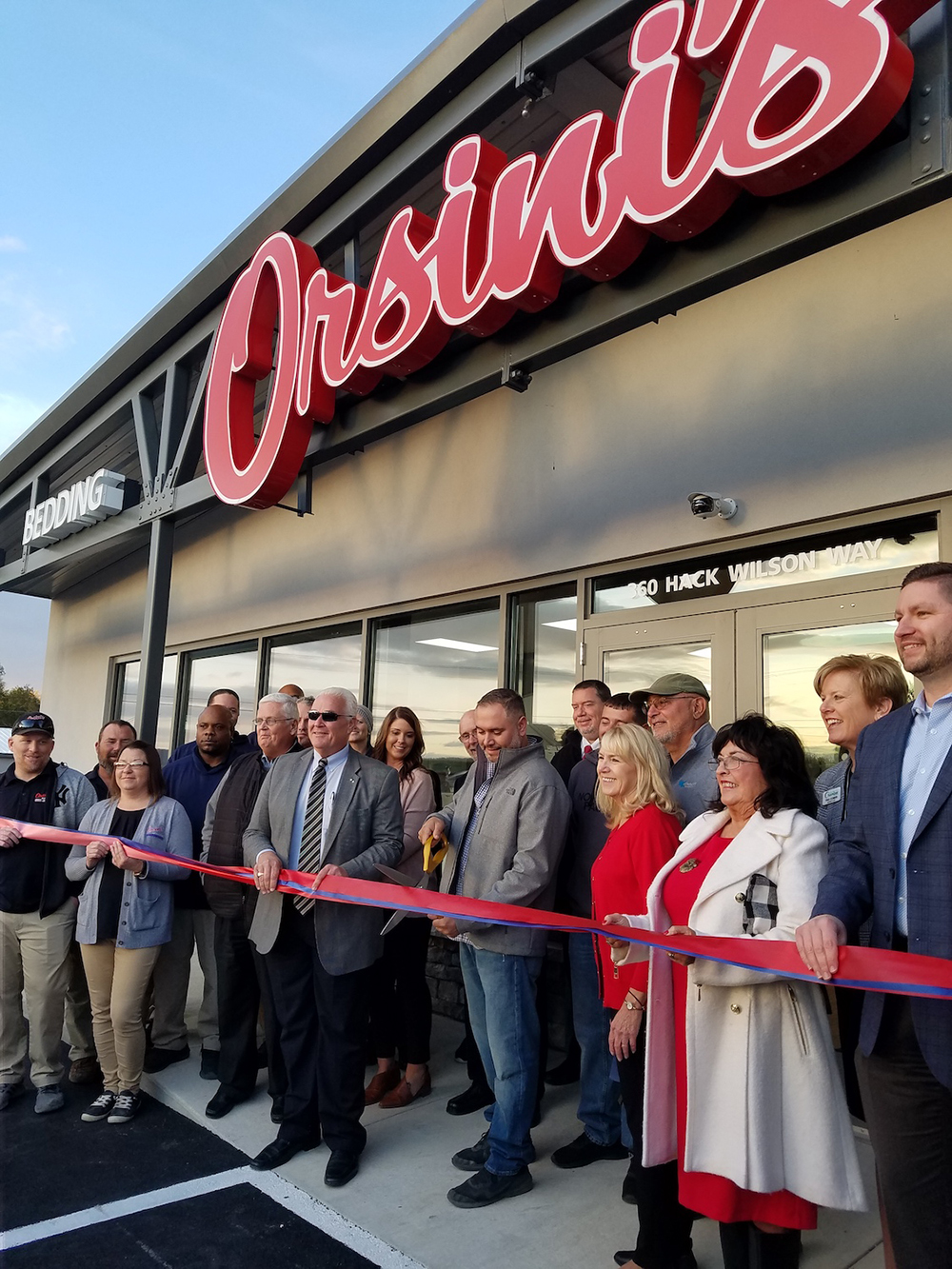





Three Generations of Excellence
PJ Orsini took over his family business in 2016 and brought a fresh perspective to Orsini’s, along with a knowledge and appreciation of its history.
BY JESSICA GUYON
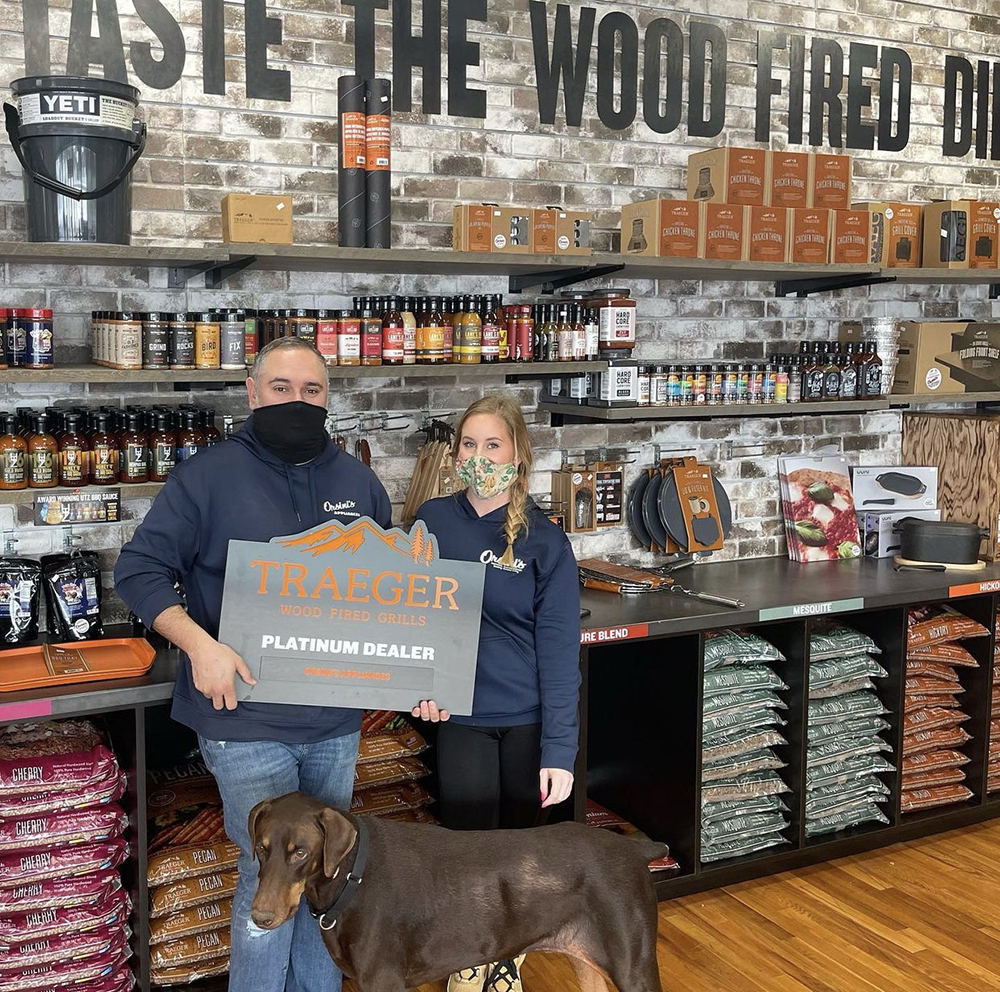

Orsini Appliances is an authorized dealer of Traeger Grills products. Pictured behind Orsini is the store’s 800-square-foot Traeger display.
After 73 years in business spanning three generations, Orsini’s has quite the rich history behind it, and one that continues today through the founders’ grandson, PJ Orsini. Orsini says his grandparents opened up the appliance shop in 1948 in Martinsburg, W.Va., and Orsini’s quickly became a staple of the Eastern Panhandle. His father and uncle took over the family business in the ’90s, heading up appliance sales, appliance services, and appliance installation until they decided it was time to retire and usher in the next generation.
When it was PJ’s turn to take charge of the decades-old retailer in 2016, one of his first orders of business was to move Orsini’s to a location that better fit current needs. The original location was just 2,400 square feet, and despite any nostalgia tied to Orsini’s first home, the business was quickly outgrowing its confines.
In 2019, Orsini’s relocated to an 18,000-square-foot location with an 8,200-square-foot showroom where it operates today. The once exclusive appliance retailer also experienced changes to its inventory along with the move. In addition to appliances, consumers will now find cabinetry, bedding, flooring, outdoor living solutions, smart home products, and more at Orsini’s.
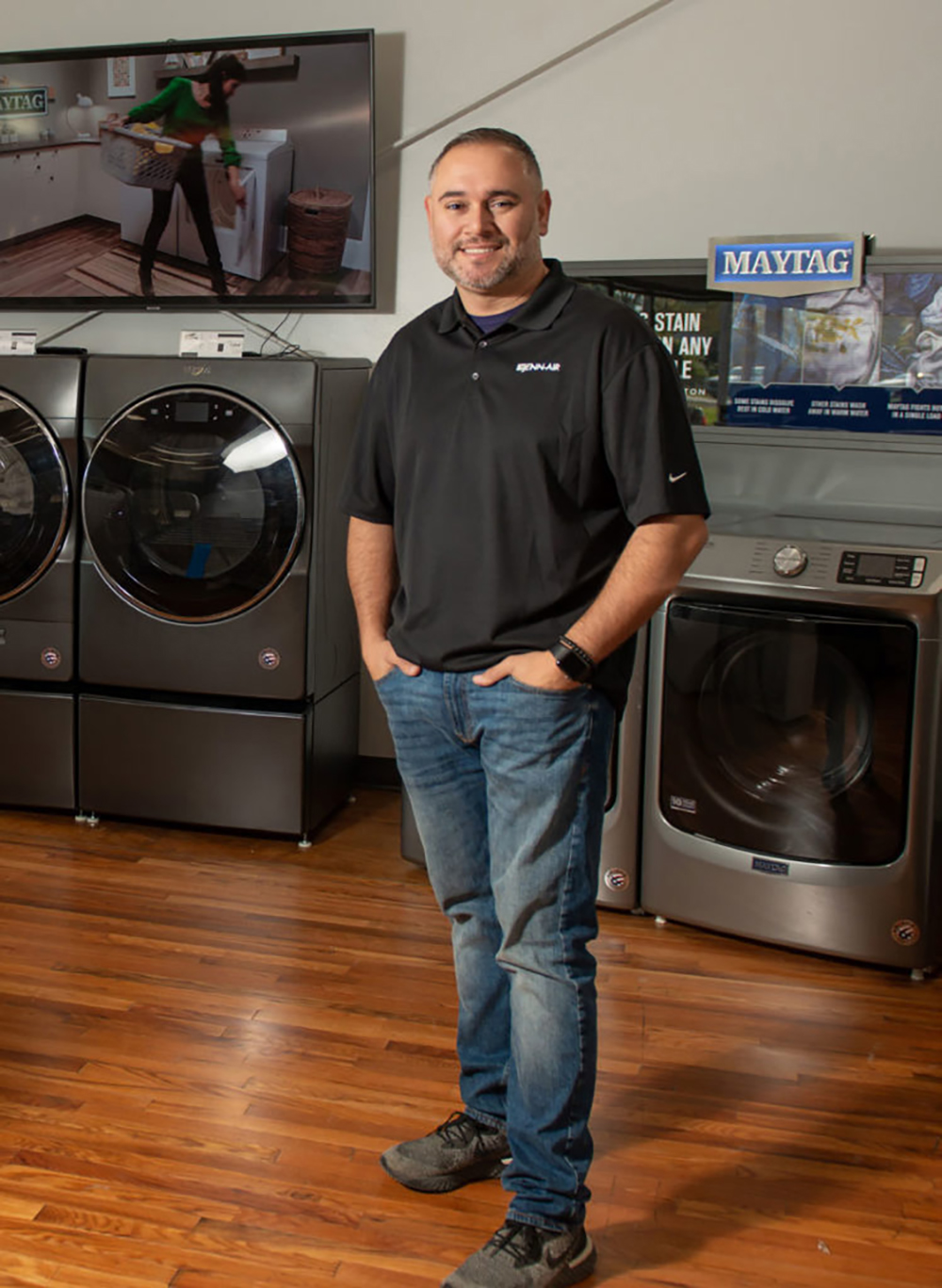

PJ Orsini is the third-generation owner of Orsini’s in Martinsburg, WV.
Digitally, the company has seen some significant changes as well.
“Retail is so much different than it ever was, and the pandemic really forced our hand to do things that we had put on the back burner,” Orsini admits. “When lockdown was at its peak and people weren’t leaving their homes, our website became our storefront, and we had to change our focus in order to meet our customers where they were at.”
One of the enhancements to the website that has been highly impactful for Orsini’s is the live chat feature that can connect customers with questions to a store associate who can answer them the same way they would inside the store. The conversation can even transition to a phone call, video chat, or text message if needed.


Appliances remain an integral part of Orsini’s product offerings. The showroom features multiple kitchen vignettes with top brands on display.
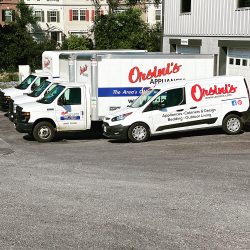

Orsini says he is looking to open up a distribution center at a separate location for a smoother loading and unloading experience.


Orsini’s carries a wide selection of Solo Stove smokeless fire pits and accessories within its outdoor living category.
As customers have been coming back into the store, with easing COVID restrictions, Orsini is working to keep that experience fresh as well.
“What we don’t want is for people to come into the store, look around and think ‘wow, nothing has changed since the last time I was here,’” he says.
One of the ways he plans to bring more of an experiential aspect to Orsini’s is by offering cooking classes on site. He purchased the building next door to the showroom and is in the process of remodeling it to become a barbecue demo space. He has a vision of hosting chefs at the location for private classes and cooking demos both as a way to bring the community together and to get them interested in the vast lineup of products and brands available at Orsini’s. Just some of those brand names include Whirlpool, KitchenAid, JennAir, Maytag, Traeger, Yeti, Nest, Ring, and more.
It’s also important that those products are listed at competitive prices. Orsini’s latest initiative in creating that consumer confidence came with the rollout of digital price tags.
Store visitors can now scan a digital price tag on a product they are interested in to compare it to big-box stores like Home Depot or Lowe’s to see if the price matches up. Most of the time it will, but if it doesn’t, Orsini’s will match it.
Beginning in just a few months, customers can even choose to finance their purchases with Orsini’s, an initiative aided in large part by the help of Nationwide Marketing Group.
“We’re excited to launch financing options in Q4 of this year, thanks to the help of Nationwide. Without them, we wouldn’t have been able to do that,” says Orsini.
He says he regularly attends Nationwide PrimeTime, both in its virtual and in-person format, and has implemented some of the strategies and benefits they offer into his store operations.
As for what’s next at Orsini’s, he says they are looking to open a small distribution center to meet the high demand for Orsini’s products and to create a better experience for both the team and their customers.
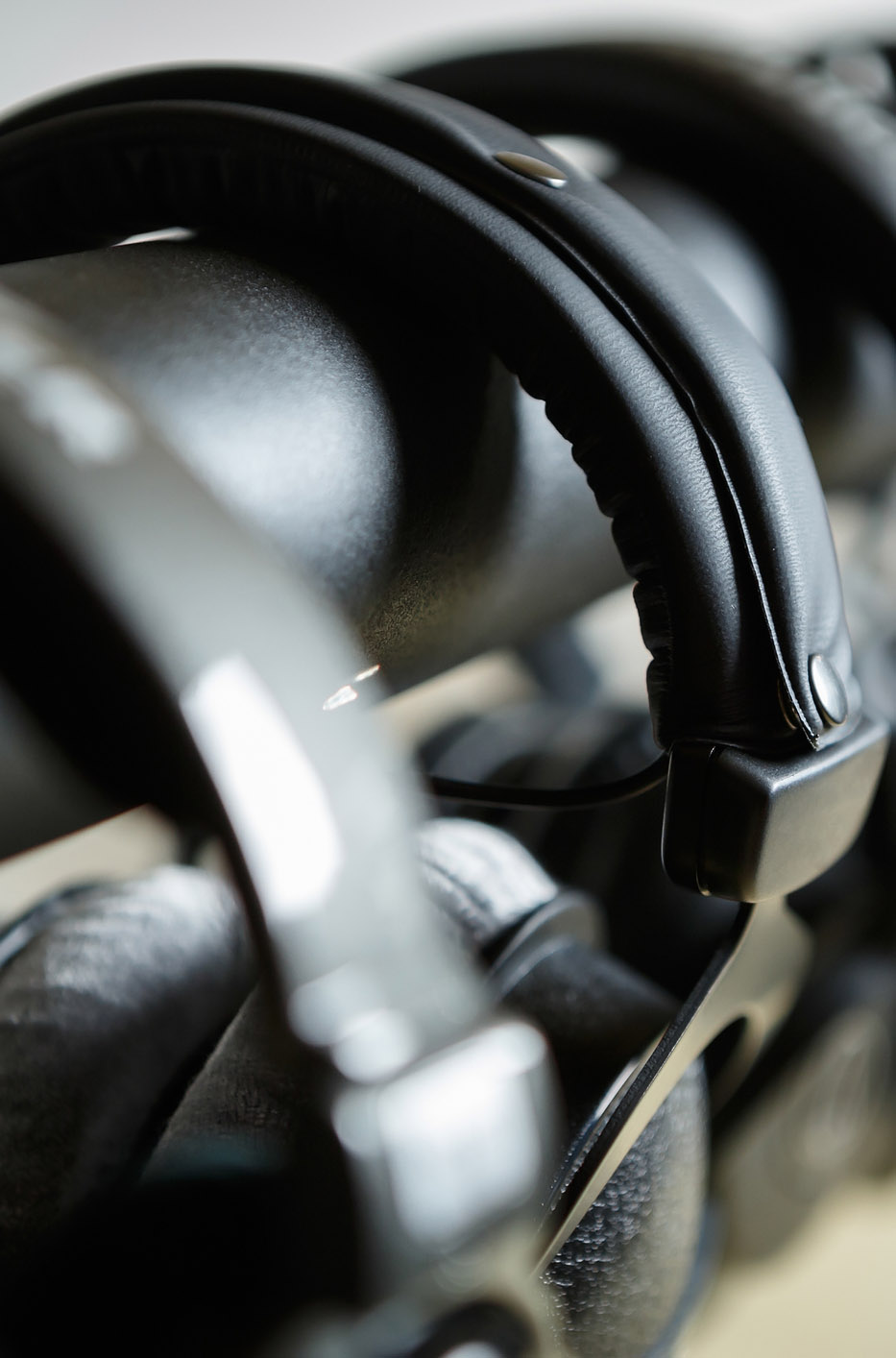





A Headphone Emporium in Manhattan
Audio46’s modest storefront belies its impressive national and international reach.
BY NANCY KLOSEK
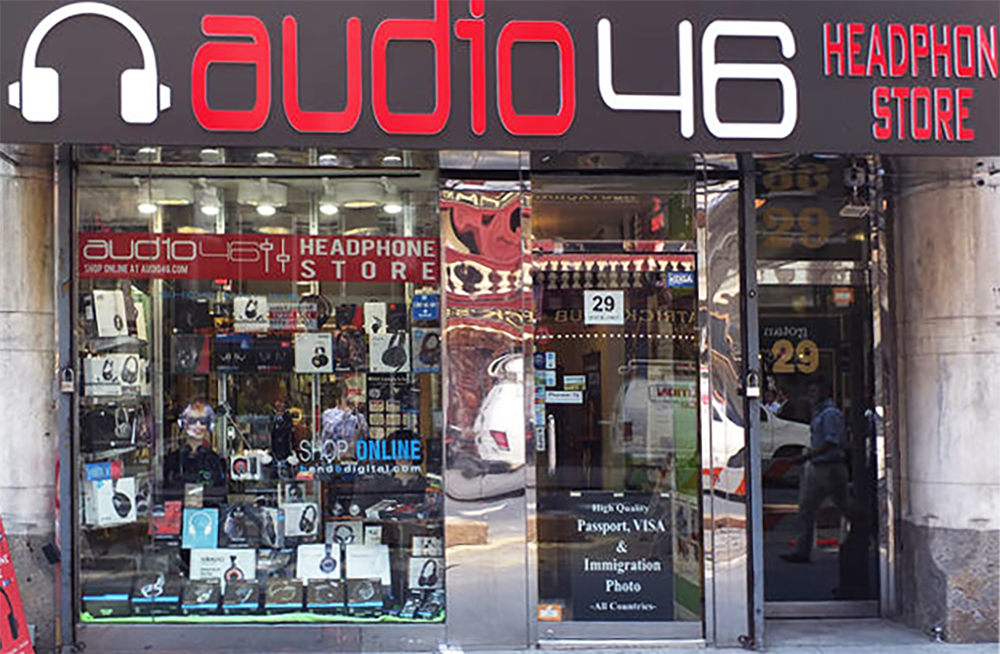

Audio46 in New York City
Situated in the heart of New York City, on a Midtown block on 46th St. off Fifth Ave. that is normally populated by a constant pedestrian stream of office workers and tourists, is Audio46, a Dealerscope 2021 Retail Excellence Award honoree. But while the pandemic has somewhat affected foot traffic these past 18 months, Tony Aama, Audio46’s vice president, says business is healthy and booming. That, he says, is due to both his many loyal, longstanding customers who appreciate the huge selection of pro and consumer headphones and other audio gear he carries, and to the store’s formidable online domestic and international presence.
Audio46 started out primarily as a B-to-B brick-and-mortar camera retailer, and then took a different turn in the aftermath of the 2008 global financial crisis, when Aama added online sales capability in 2009. And in 2013, he continues, “we noticed another shift — we were getting customers walking in asking for more audio brands. So we started adding them, and began to carry a lot more high-end audio brands.” The boom in consumer usage of smartphones as cameras also helped Aama in reaching his decision to train Audio46’s category focus more acutely, and in the direction of solely catering to a different set of loyal hobbyists: audio-lovers.
Aama says that prior to the pandemic, over 80 percent of sales were transacted in-store — something that dramatically changed when COVID hit full force. This shift, however, enabled him to leverage his unique advantages as an audio/headphone retailer. “What happened was, Amazon during that time [March and April of 2020] was busy fulfilling essential items. So a lot of audio customers were looking for where to get their products. That’s when they found Audio46. They wanted beyond just the essential products — they needed headphones and audio equipment, and to buy from Amazon, they had to wait 15, 20, or 25 days. They started looking somewhere else, and that was how they found us. And that’s when our online business went crazy, because we could do two-day and three-day delivery times… It boosted our online platform.”
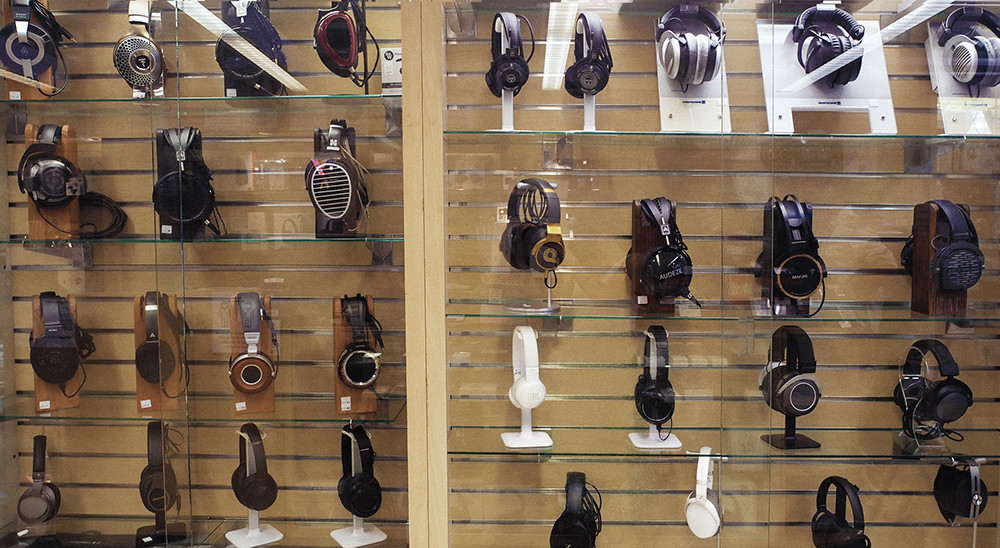

Audio46 carries over 80 brands across a broad spectrum of price-points.
Leveraging an International Reach
One strategy that was adopted to enable the smooth execution of online sales was the addition to the website of online chat in early 2020 — an almost clairvoyant move, given how business circumstances changed for all retailers later in the year.
Audio46 can also boast an extraordinarily strong YouTube social media footprint.
Besides having a robust English-language channel, one of the retailer’s crowning achievements on that platform is its Spanish-language Audio46 en Español YouTube channel, which has attracted 167,000 subscribers. Aama also communicates to buyers via YouTube channels in Korean, Chinese, Russian, and Portuguese; all of these portals enable viewers to dive deep into educational tech tutorials and product reviews about the more than 80 audio brands carried. “And we are expanding that brand number every month,” Aama says.
The retailer offers free shipping for U.S. orders across the continental U.S. with no minimum order required, and provides an option to select FedEx same-day delivery.
The store’s YouTube channels offer a constant stream of tutorials and product reviews
“We have both availability and a broad selection, all under one roof,” says Aama, and the store recently added another floor above street level to enable easier social distancing and to provide more room to shoot the online videos. The 4,000-square-foot location includes an office and a warehouse, with 1,500 square feet of that earmarked as showroom space.
In-store browsers are invited to try headphones before buying, but Audio46 adheres to CDC protocols, tracking and then strictly following evolving social distancing and mask requirements, constantly cleaning displays and demo areas, and making alcohol swabs and disposable ear tips available.
Physical territorial expansion is also on the retail roadmap for 2022 for Audio46, Aama says, with plans in the works past the pandemic period to open locations in states other than New York.
“When you’re looking to buy a high-end headphone, you lean towards a place where there is a large selection, and where people can try them. That sets us apart from Amazon, and aside from a couple of dealers, there aren’t physical locations like that — and I don’t think many of those have the breadth and choice we have in headphones.”
Aama subscribes to a tried-and-true philosophy that is at the foundation of his retail success story. “The name of the game with customer service is that there is no one-size-fits-all — you have to be flexible, listen to customers, and have an open mind. This is how we drive customer loyalty.”


HEALTH & WELLNESS
Reduce the Friction
The rise of virtual reality fitness experiences.
BY EGON SANDERS
With gyms and fitness centers being some of the hardest-hit industries by the pandemic, it’s no surprise that home fitness — and sales of the products to support it — surged during the pandemic. Many bought exercise machines, weights, Pelotons, yoga mats, and all manner of other gear: According to NPD retail data, health and fitness equipment revenue more than doubled to $2.3 billion from March to October. Sales of stationary bikes tripled, while treadmills shot up 135 percent; Peloton reported revenue of $758 million in 2020, a 232 percent increase from the same period the previous year. During the same period, interest in and sales of virtual reality headsets received a bump as well. Stuck inside for months on end, many found refuge in VR as a means of virtually escaping the confines of their own domicile. While we don’t know the exact number of VR headset sales out in the wild today, there’s reason to believe that number is now in the tens of millions. As of January 2020, PlayStation VR alone had sold 5 million units, and that’s only one of the many VR headsets on the market; there’s speculation that the Quest 2 tripled its sales rate. Likewise, 71 percent of headset owners say they spent more time in VR during the pandemic.


Supernatural VR uses a subscription model for its VR workouts.
Analysts concur. “Since the launch of the Quest 2 up until now (the nine months from October 2020 to June 2021), VR hardware sales have grown 163% YOY,” NPD consumer electronics industry analyst Ben Arnold told Dealerscope. “We expect 2021 will end the year 40% to 50% above sales levels we saw for 2020.”
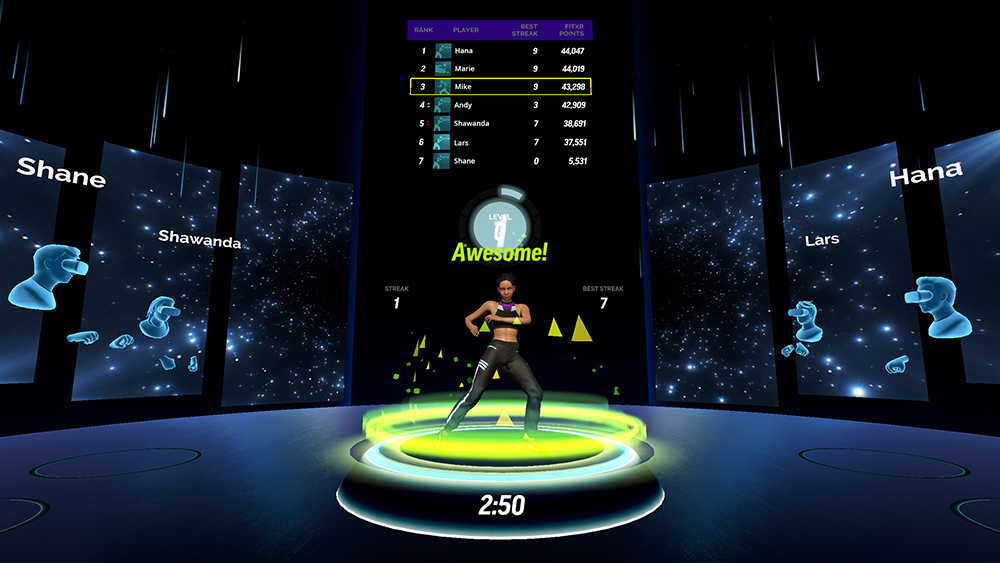

VR’s rising popularity has coincided with the rising popularity of home workouts.
This combination has found a sort of synergistic overlap in the rising popularity of virtual reality home workouts. Indeed, VR exercise can take many forms. Supernatural, for instance, sends objects and targets flying toward you, tasking you with squatting beneath the former and punching the latter, and progressing through various locations around the world while doing so. FitXR, on the other hand, taps into one’s competitive spirit: with up to six other VR users joining for boxing or cardio dance classes, as the users attempt to outscore their opponents in tests of speed and dexterity. RacketNX is like pinball meets racquetball. There is also a whole host of “accidentally exercise” experiences on the market, like the massively popular rhythm action game Beat Saber (which is essentially like Rock Band or Guitar Hero, but using your arms and legs rather than plastic instrument controllers to hit note timings), as well as the strenuous climbing simulator The Climb. (While not typically branded and marketed as exercise experiences, plenty of folks are using these games as such.) Many of these experiences employ subscription-based business models, with subscribers gaining access to new routines and workouts each month.
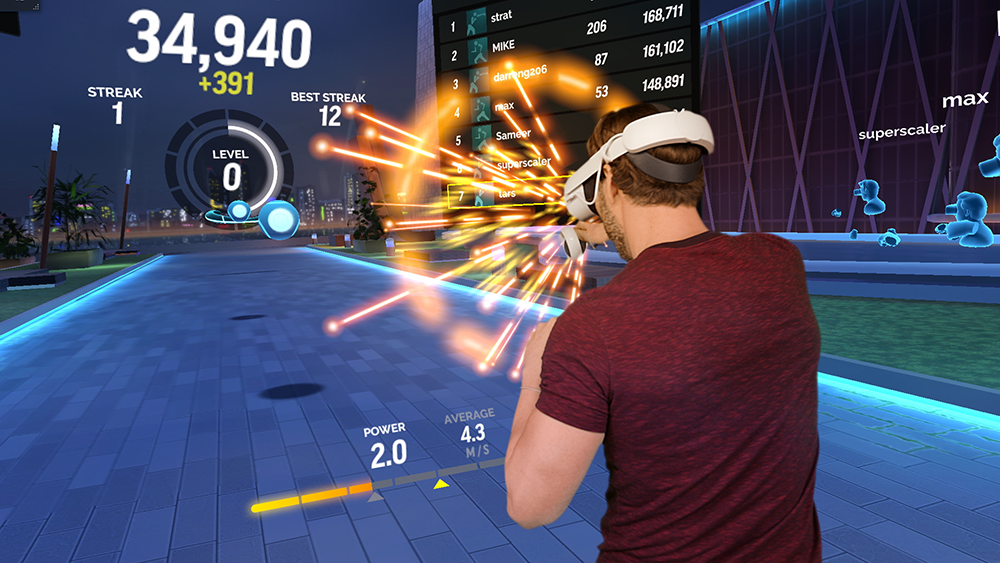

NPD estimates that 2021 VR sales will end the year 40 to 50 percent above 2020 levels.


FitXR pits users against one another for competitive workouts.
Interface-wise, not all of these VR exercise experiences are standalone. Several VR cycling apps require the user to own a specialized stationary bike, or more conveniently, an affordable sensor that allows any stationary bike to work in VR. (Some apps, like Holofit, are compatible with any bike that supports the FTMS Bluetooth protocol — no extra sensors required.) Likewise, several apps allow users to incorporate their existing elliptical or rowing machines in a similar manner, with software built around the unique kinds of fitness interfaces they provide. Instead of rowing or cycling in your living room, one can instead row through exotic locations around the world, with dynamic goals and challenges rather than self-imposed ones.


VirZoom takes users through epic landscapes as a means of escaping the constraints of one’s own living room.
In terms of hardware, most of the popularity seems to be centered around the Oculus Quest and Quest 2 headsets, for a handful of reasons. Both versions are among the most affordable VR headsets out there; if you’re going to be sweating all over a gadget, better it be a $300 Quest than a $1,000 Valve Index. The Quest also has perhaps the largest selection of exercise-centric titles (though many are certainly available on other platforms). Perhaps most of all, however, it’s the all-in-one, untethered nature of the Quest that seems to be making it the platform of choice for working out in VR. Rather than being tied to a PC via a number of nagging cables, having the freedom to move around your indoor or outdoor space with abandon (still minding the furniture/windows/pets/cliffs, naturally) makes for a freer, more natural exercise experience.
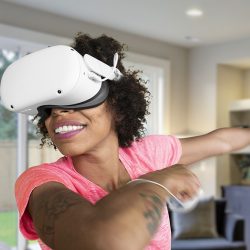



Retailers are perfectly positioned to leverage VR’s rising appeal as a means to fitness.
Even as the pandemic becomes less acute, it seems likely that many will continue working out from home. One of the primary drivers here is convenience, and VR certainly benefits from this. Rather than having to drive or otherwise commute to the gym for a 30-to-60-minute workout, simply putting on a headset for a few shorter workouts throughout the day can have the same cumulative effect, and better break up one’s workday. The fact that these experiences are “gamified” — that is to say, built around technology and game mechanics that make working out more engaging, and feel like less of a chore — is also a major factor. In a few studies, what’s called the “rating of perceived exertion” — that is, the participant’s notion of how hard they feel they’re working when exercising — has been found to be lower in VR exercise, compared to when engaging in typical exercise. In other words, one’s perceived exertion is lower than what it actually is, which produces better results and longer-term commitments. And isn’t that what exercise is all about? Fitness applications represent another potential killer app for the rapidly advancing and expanding technology of virtual reality, and retailers would be well served to leverage this unique opportunity to get more consumers working out at home.
EVENTS


Welcome to the First In-Person Nationwide PrimeTime in 18 Months
Nationwide Marketing Group (NMG) celebrated its 50th Anniversary at PrimeTime, the first-in person iteration of the event since February 2020, last month in Nashville. Some 3,000 Nationwide members and manufacturers descended upon the Gaylord Opryland Resort and Convention Center for three-and-a-half days of networking, learning, buying, product- discovery, and more.


Watch our exclusive panel discussions and one-on-one interviews with the Nationwide experts and leaders in the consumer electronics and appliance sectors.
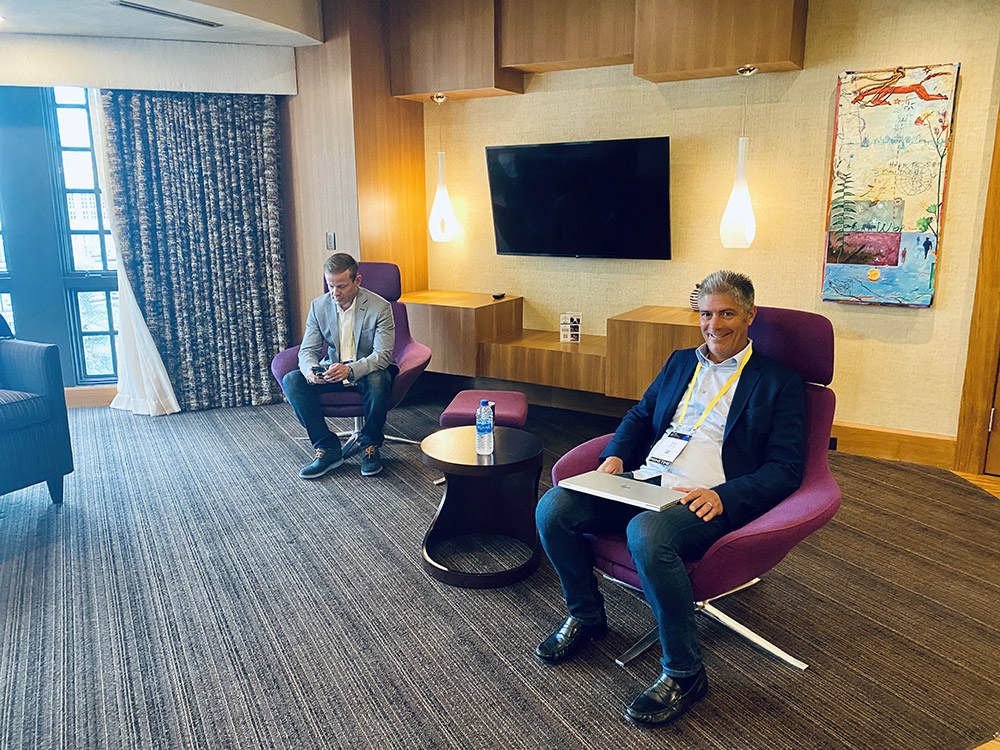

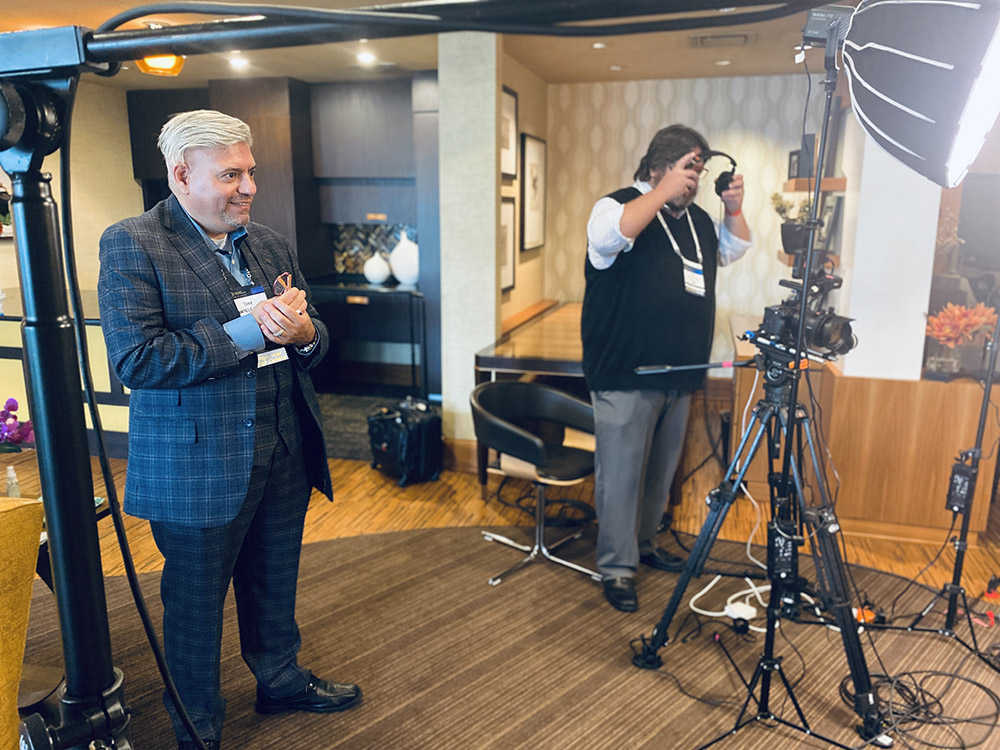

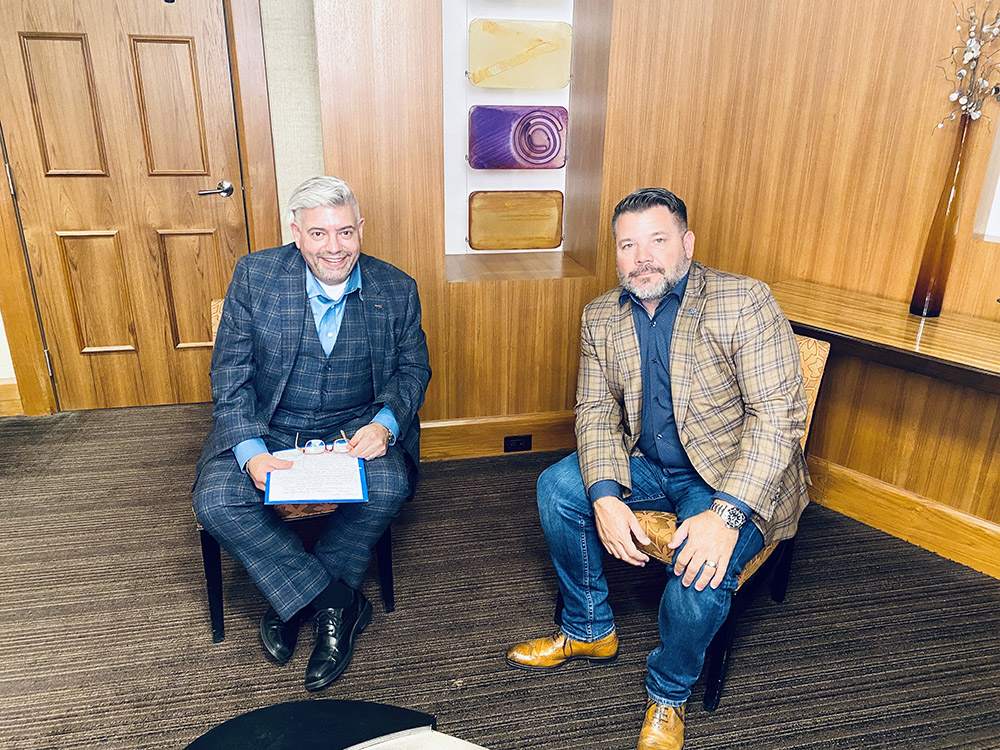

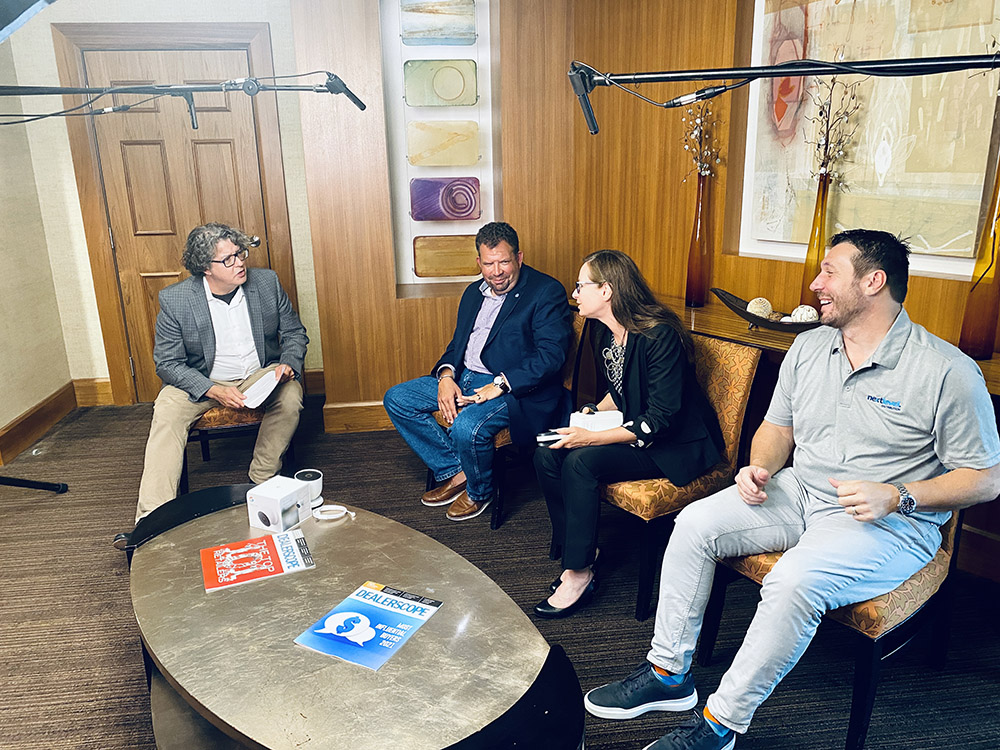





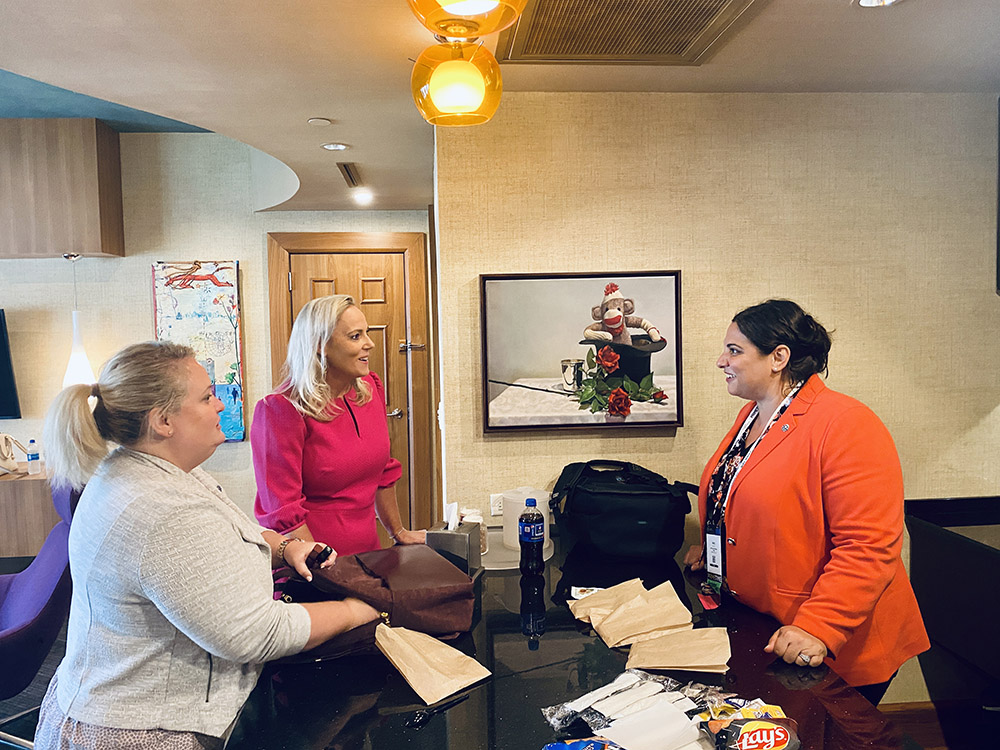



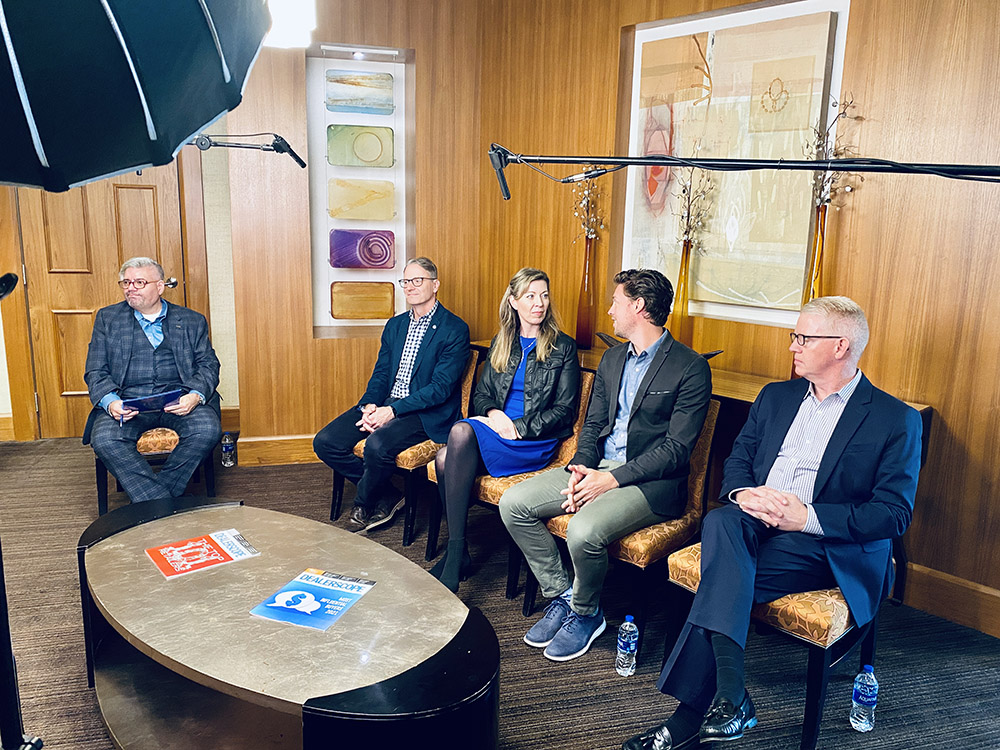

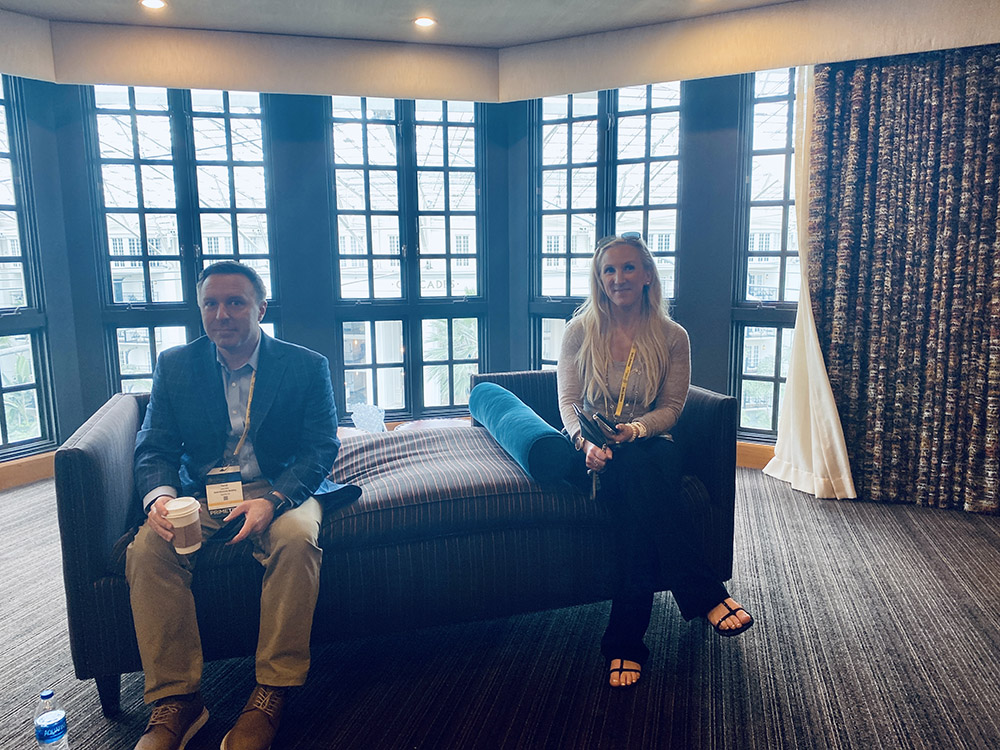

STAT SHOT
CE Industry By Numbers
COMPILED BY SAM HITT
144
… the impressive Dxomark smartphone camera benchmark score achieved by Huawei’s new P50 Pro smartphone, which is considerably higher than Apple’s iPhone 12 Pro Max’s score of 130. U.S. consumers, however, will not be able to download apps from the Google Play store or purchase the phone, at least stateside, due to the FCC’s ban on Huawei products.


$16
… Million raised by Spectricity to further research and development into hyperspectral sensors and imagers for mass-production applications. The sensors are to be used in devices such as wearables and smartphones. The hyperspectral sensors allow the device to measure users’ heart rates, amount of bloodstream oxygen, and skin hydration levels.


2
… Black Friday sales events that Best Buy will be running in 2021. Opting not to wait until November, Best Buy brought a Black Friday sale to consumers over the weekend of July 23 to 25.


100
… miles that Zero’s new 2022 FXE Electronic motorcycle has the capacity to travel, in between charges. Boasting a single, double-size 7.2-kWh battery pack, the 2022 FXE is able to reach a top speed of 85 mph.


100%
…. autonomous is the robotaxi service being planned by Aurora. The Silicon Valley mobility startup has partnered with Uber, from which it purchased its autonomous vehicle division in 2020, for ride data. By analyzing rider and driver usage and speed patterns, Aurora will be able to optimize its service, which is set to launch by 2024.


DEALERSCOPE PODCAST
Welcome to the Dealerscope Podcast – Your Source for all B2B trends in Retail, Tech and Biz!
In the high-strung consumer electronics retail business, it can be hard to take a moment to step back and breathe. The Dealerscope Podcast gives CE retail leaders the chance to kick back, relax, and talk shop in a casual setting.


CONSUMER TECHNOLOGY CALENDAR
Upcoming Events
TV and Projector Shootout:
September 12-13, 2021
https://valueelectronics.com/tv-shoot-out-evaluation/
Parks Associates Connections:
Home Networking and Wi-Fi:
September 22, 2021
http://www.parksassociates.com/events/connections-us
NAB Show:
October 9-13, 2021
Refresh Your Subscription!
Get Dealerscope and Connected Design delivered to your doorstep or to your email.
How, where and when we work has changed dramatically. We realize that these changes in your work habits may have impacted how you receive your issues.
Click on the links below to update how and where you receive your issues! Change your mailing address or request a change from print to digital, or just head to our websites.
EDITORIAL
EDITOR IN CHIEF
Tom Samiljan
tsamiljan@ctlab.media
CHIEF EDITOR DIGITAL CT LAB
Jessica Guyon
(267) 266-1432
jguyon@ctlab.media
CONTRIBUTORS
Stephanie Adamow
Sam Hitt
Nancy Klosek
Erinn Loucks
John R. Quain
Shrenik Sadalgi
Egon Sanders
Mark N. Vena
Vanessa Zitzmann
CREATIVE
Astrid von Krenski
(940) 727 8595
avkrenski@ctlab.media
EDITORIAL OFFICES
100 S. Juniper St., 3rd Floor
Philadelphia, PA 19109
dealerscope.com
CHIEF OPERATING OFFICER
Alice Schmalzl
(940) 612-9581
aschmalzl@ctlab.media
GROUP PUBLISHER
Tony Monteleone
(718) 216-2046
tmonteleone@ctlab.media
OPERATIONS MANAGER
Vicki Manucci
vmanucci@ctlab.media
CIRCULATION & DISTRIBUTION
Carrianne Ramsey
cramsey@ctlab.media
Reprints
Contact Publisher
List Rental, Postal/E-mail
Contact Publisher
Publisher of Dealerscope, and Connected Design
Copyright ©2021 CT Lab Global Media LLC
CT Lab Global Media is a diversified publisher of business and professional magazines. This publication is provided with the express understanding and agreement that the information and data within it will be solely for internal use and will not be used for the creation or updating of mailing lists for sale or distribution to third parties. Printed in the U.S.A.




